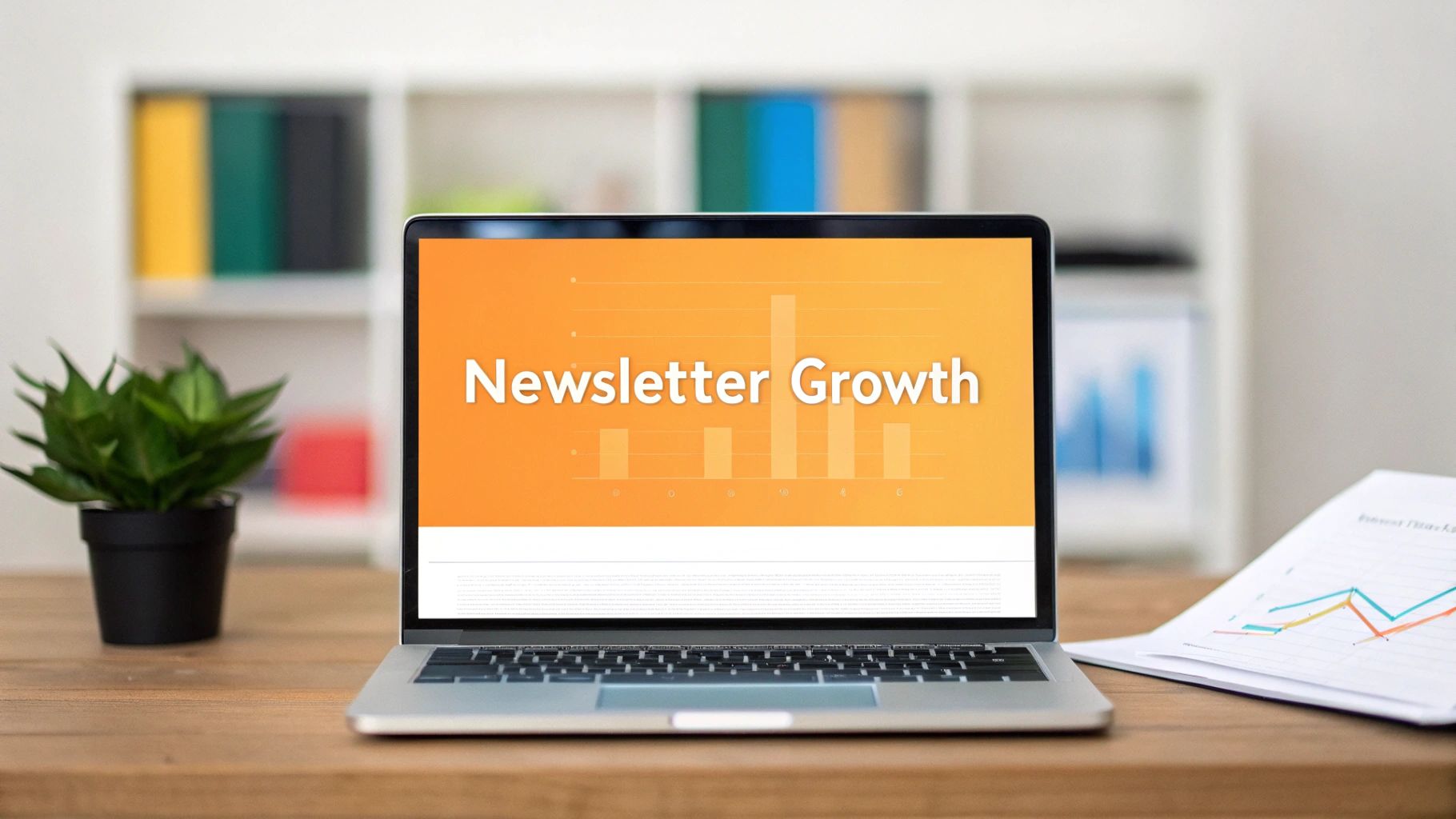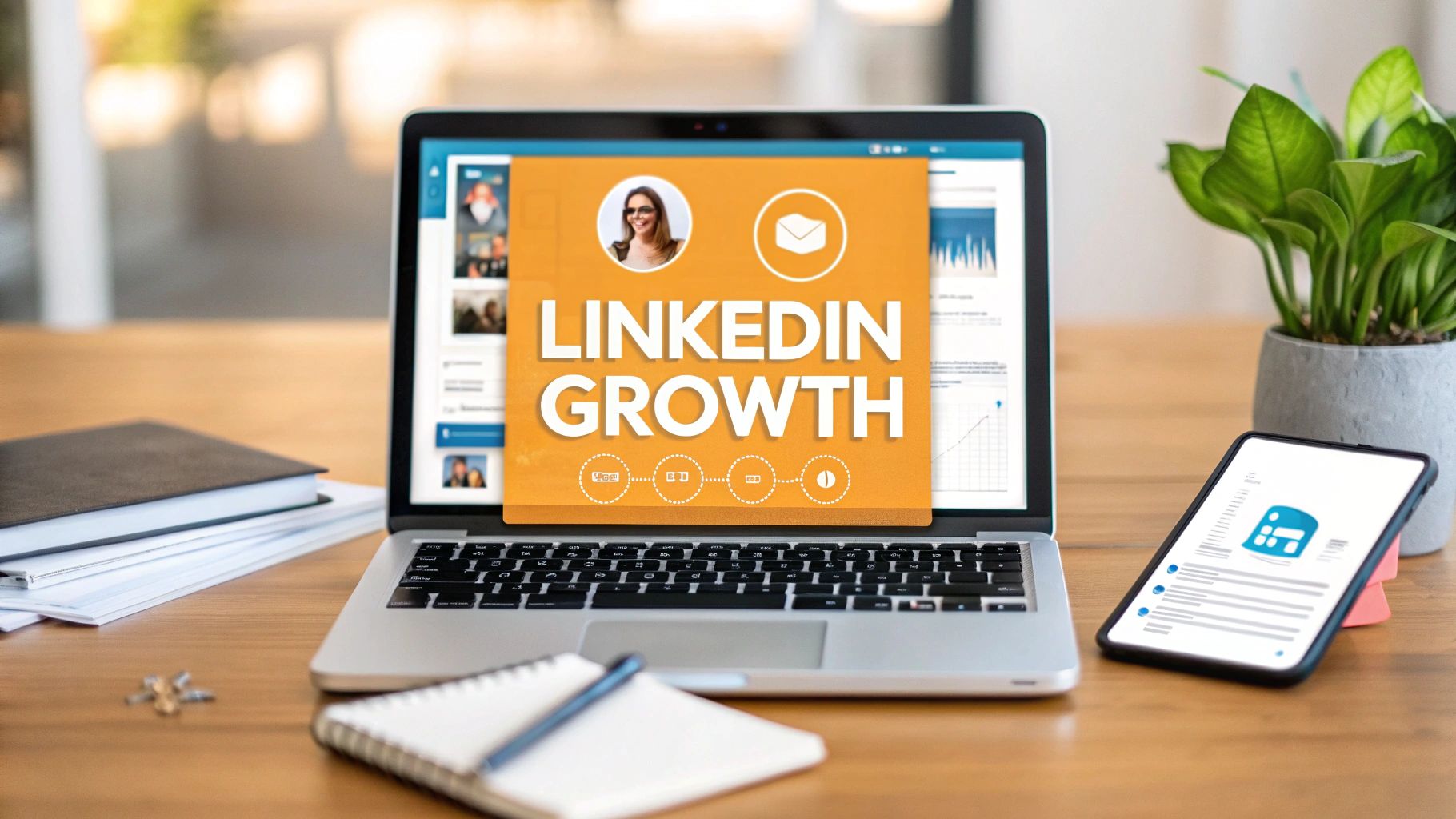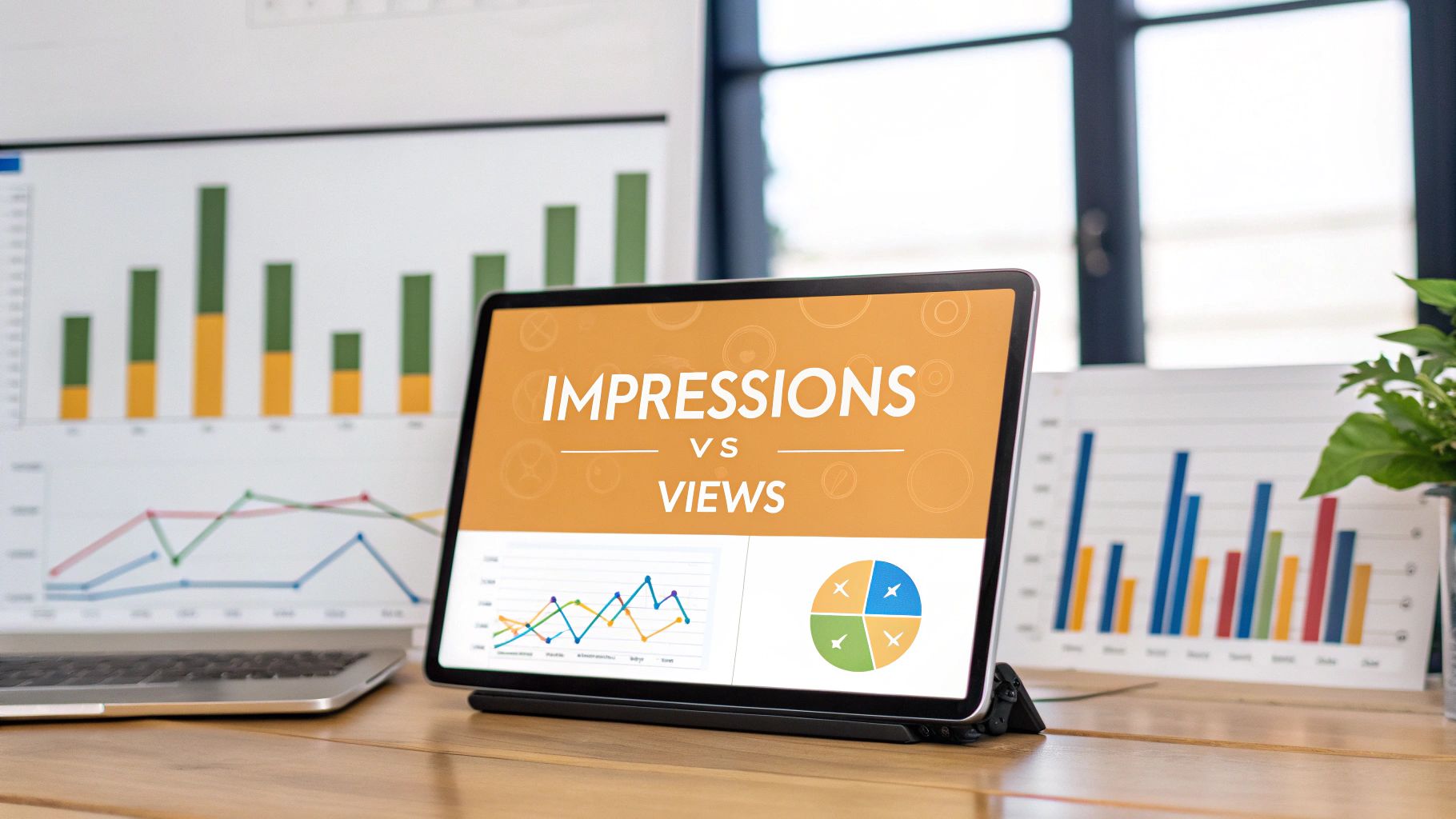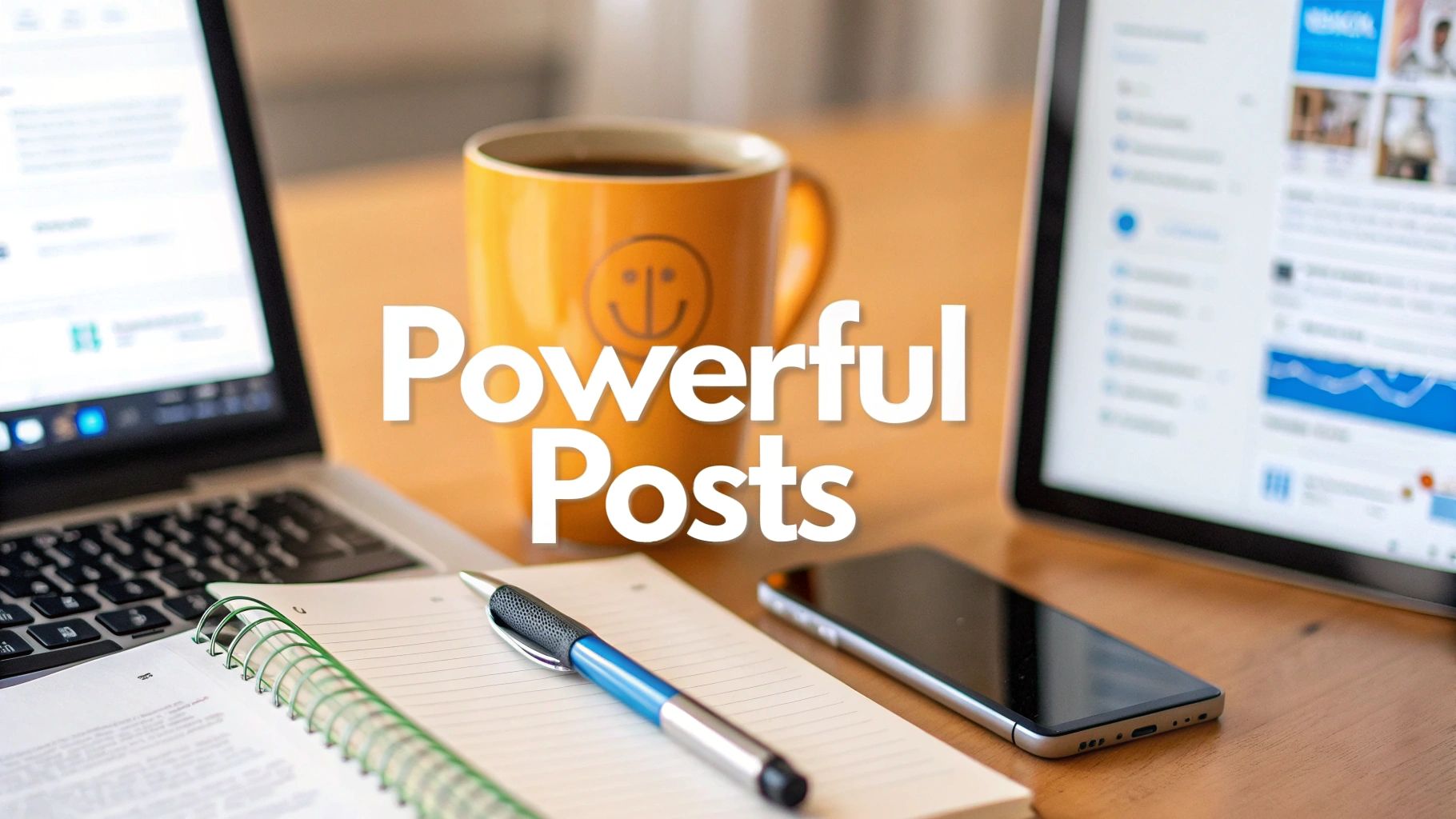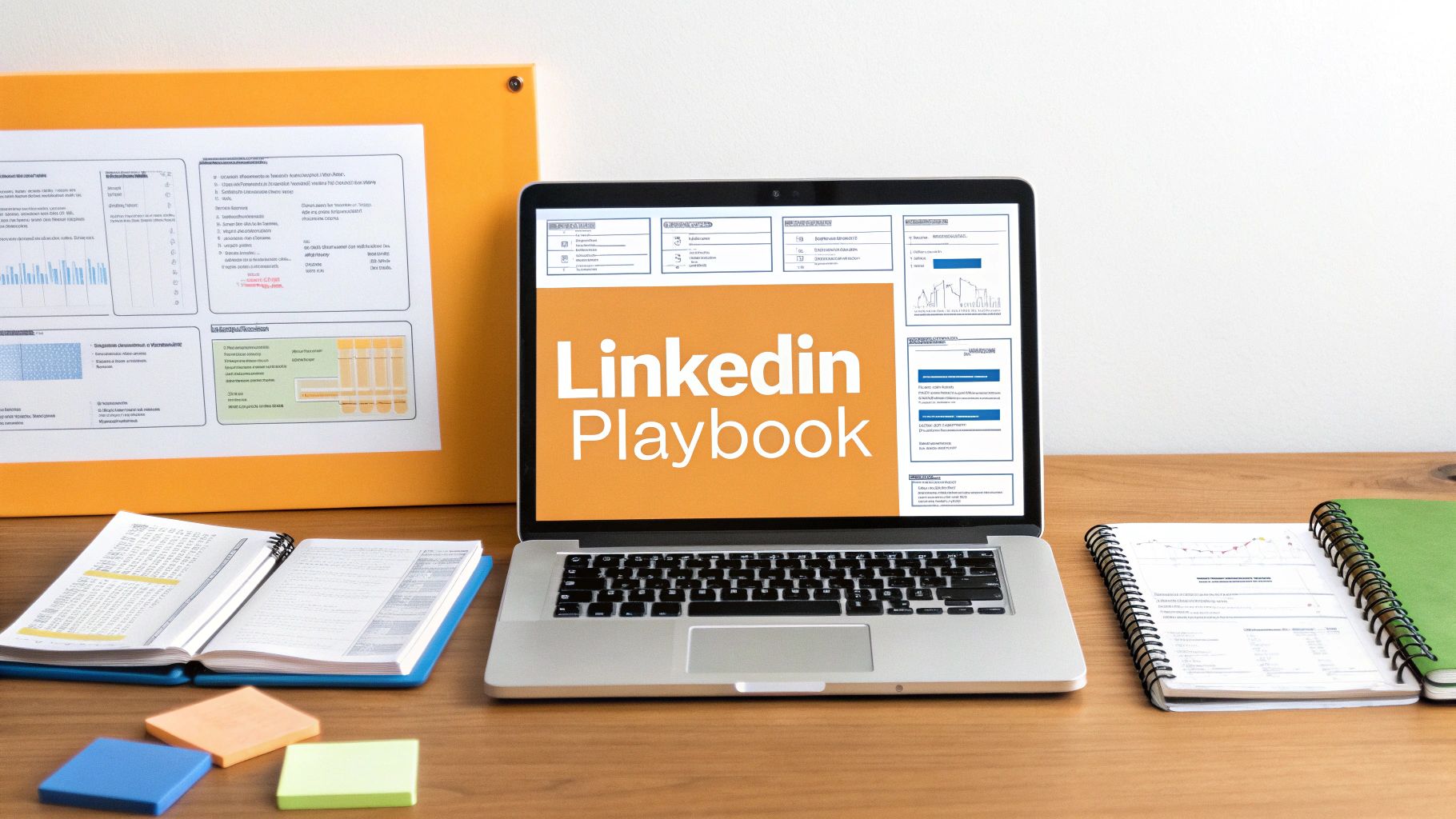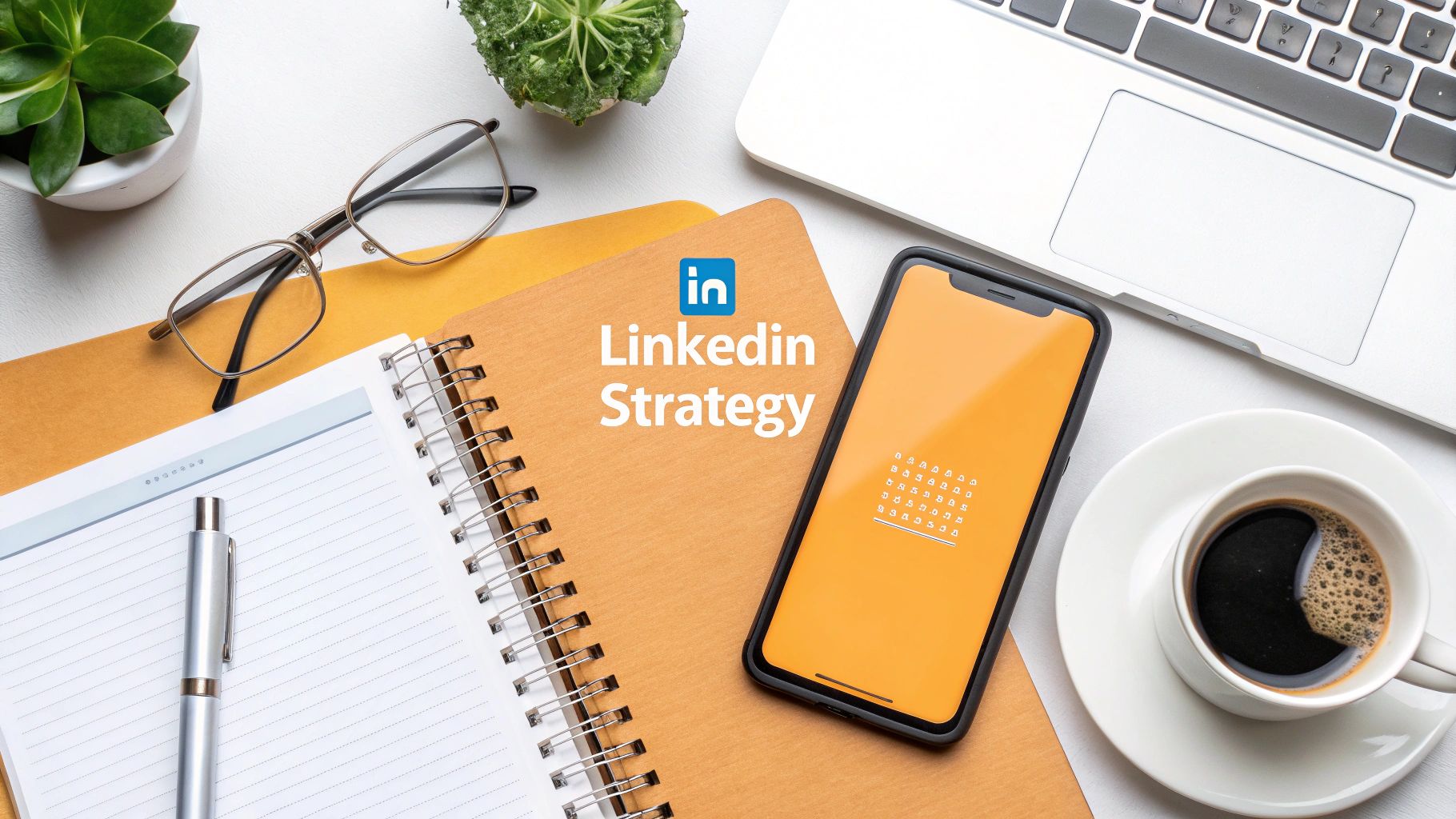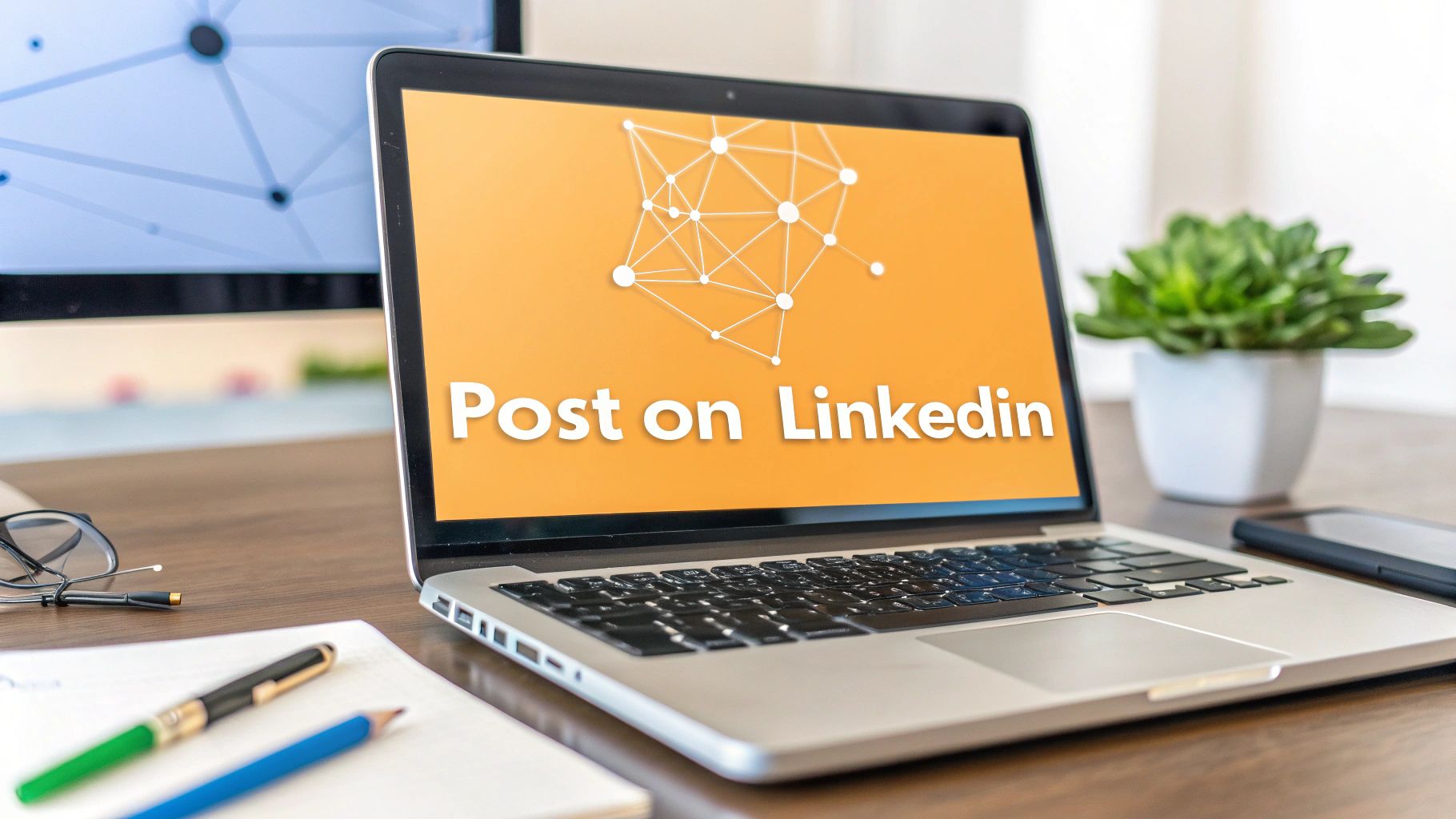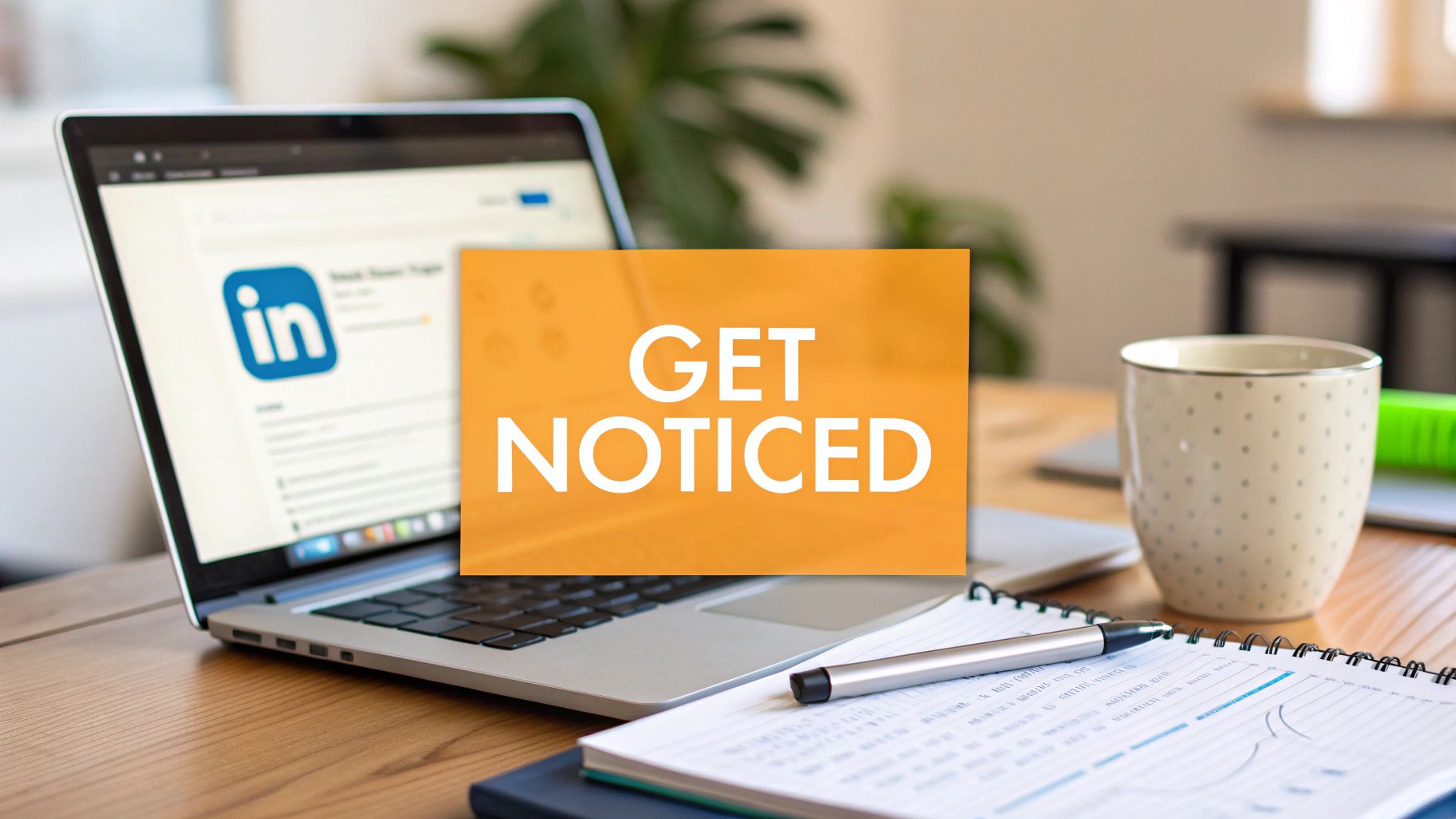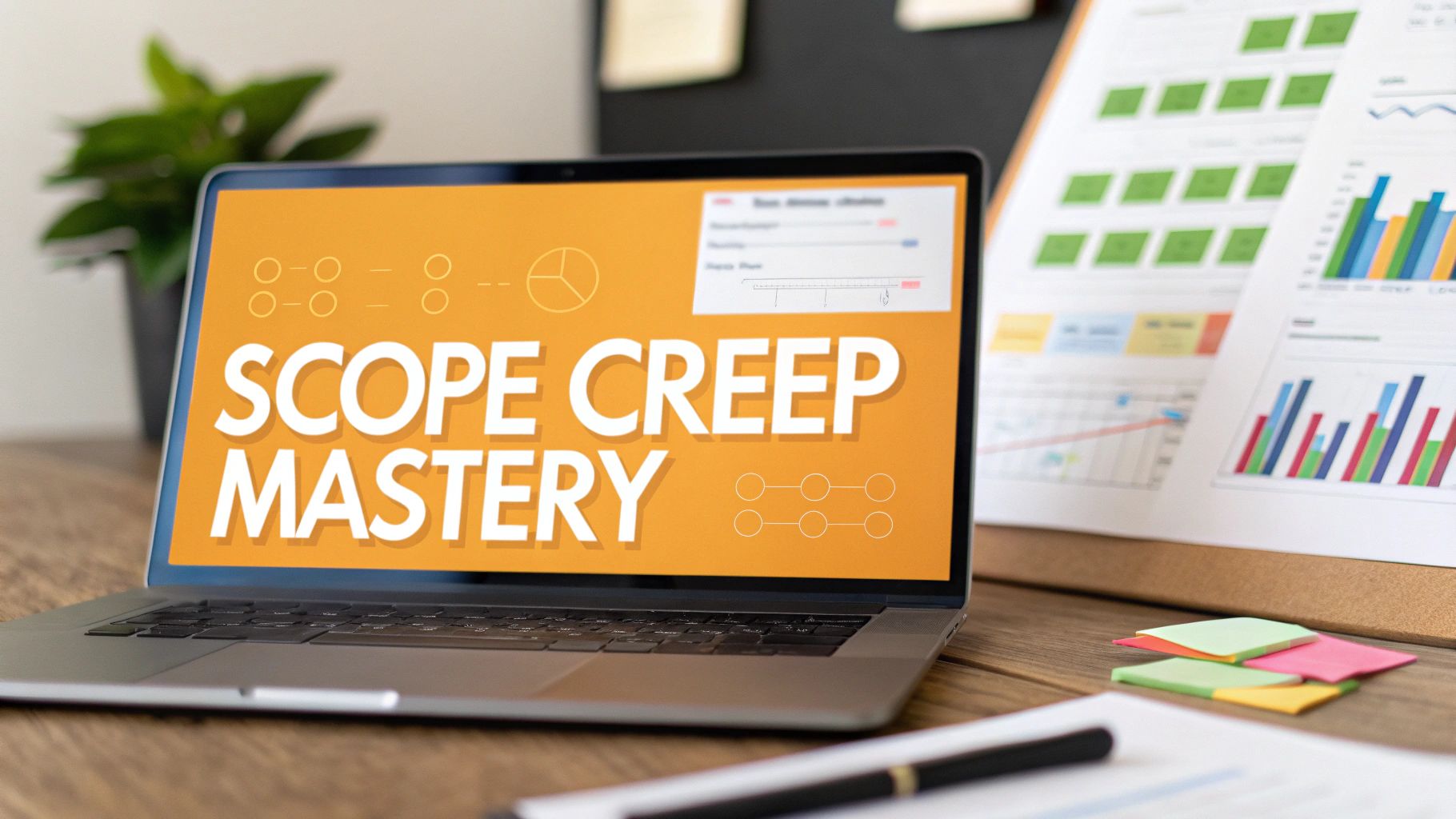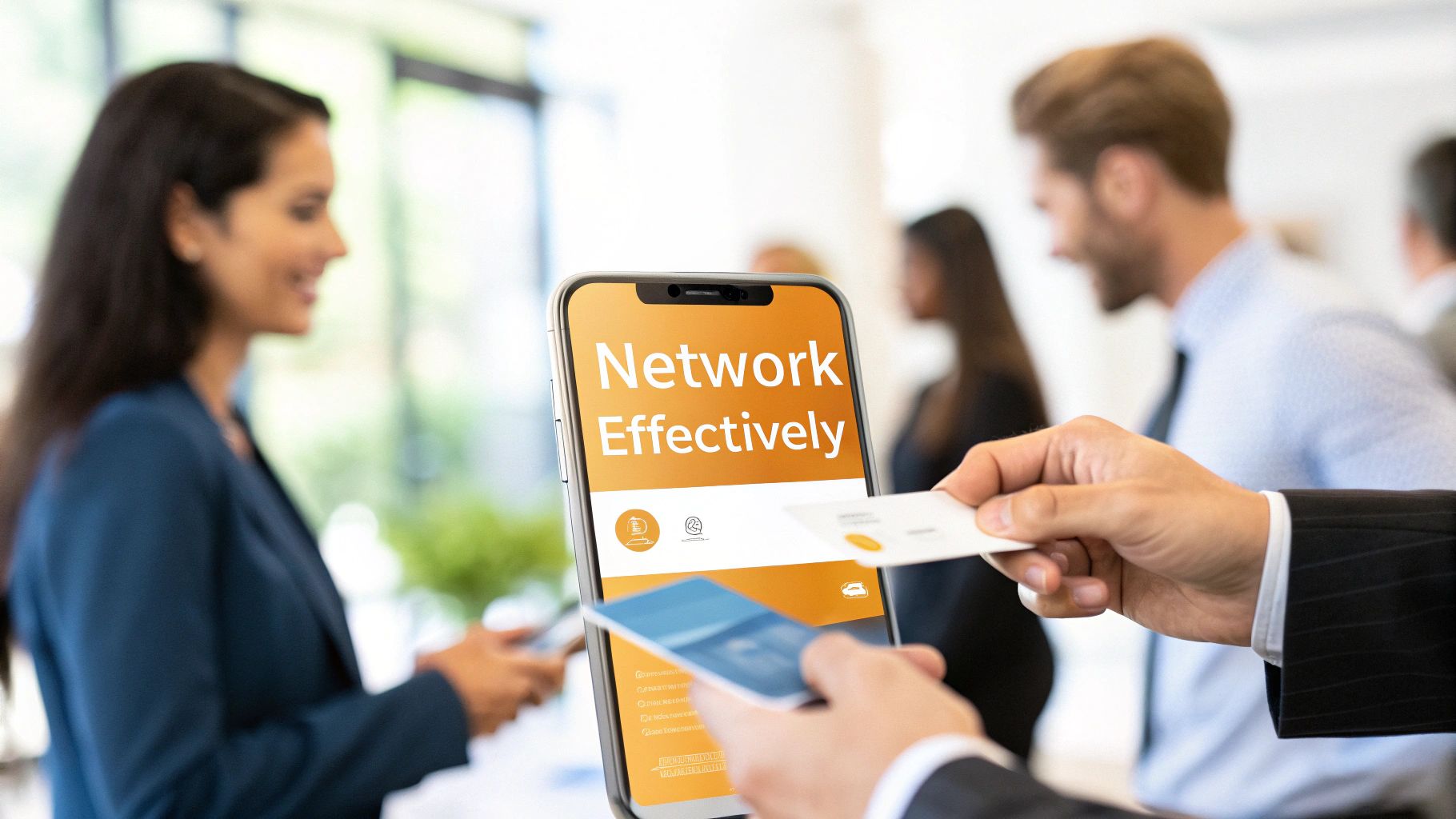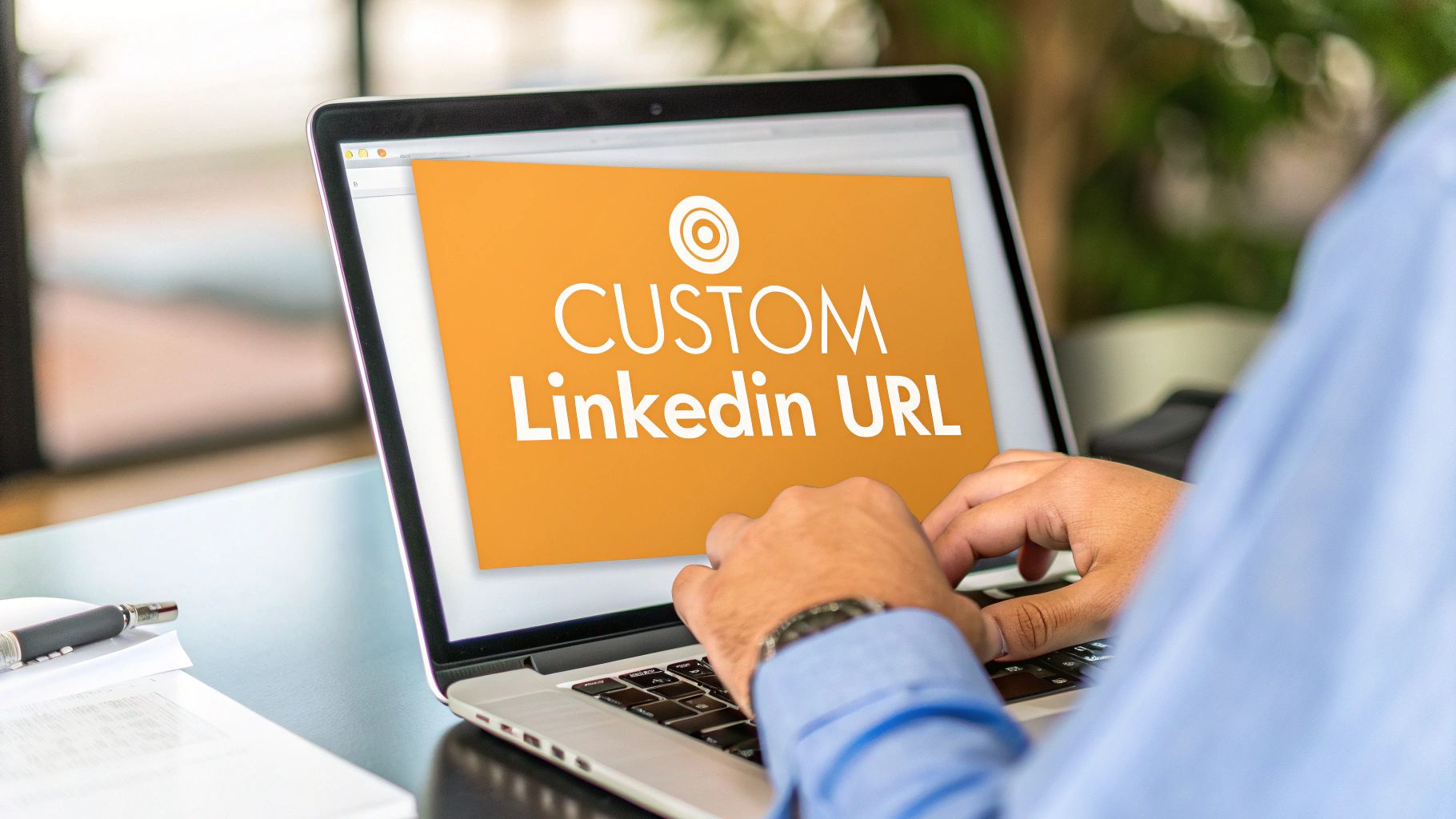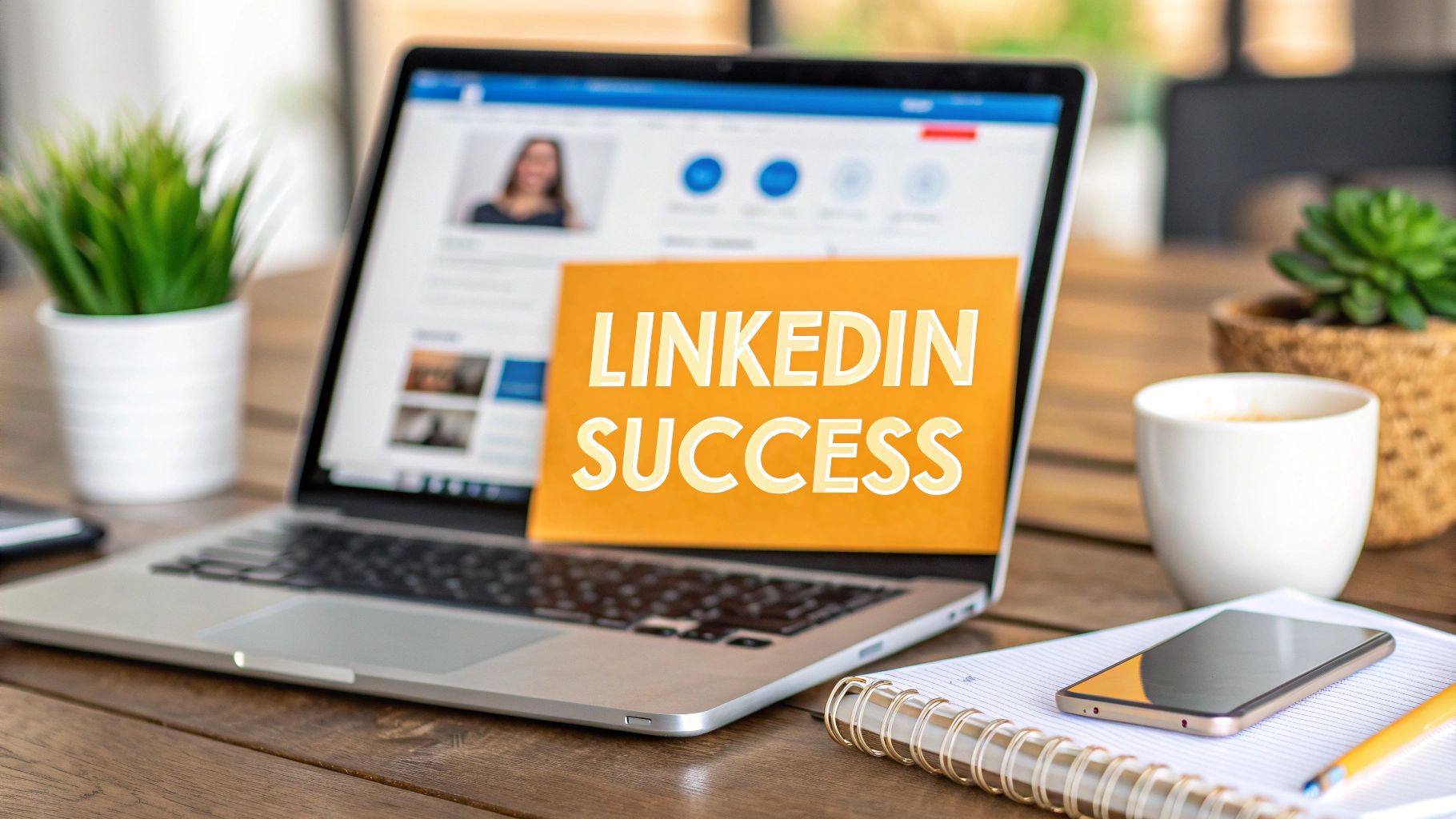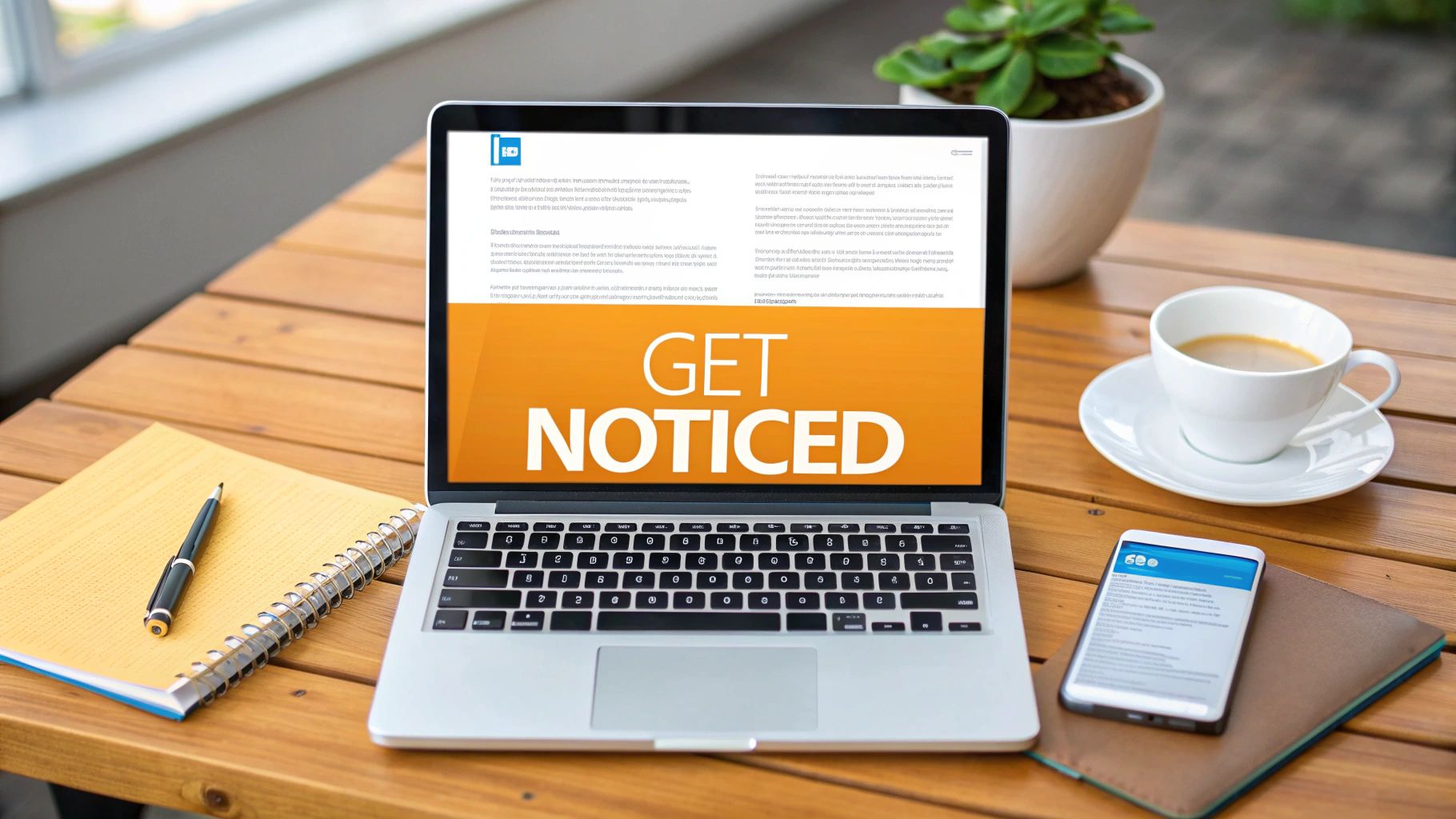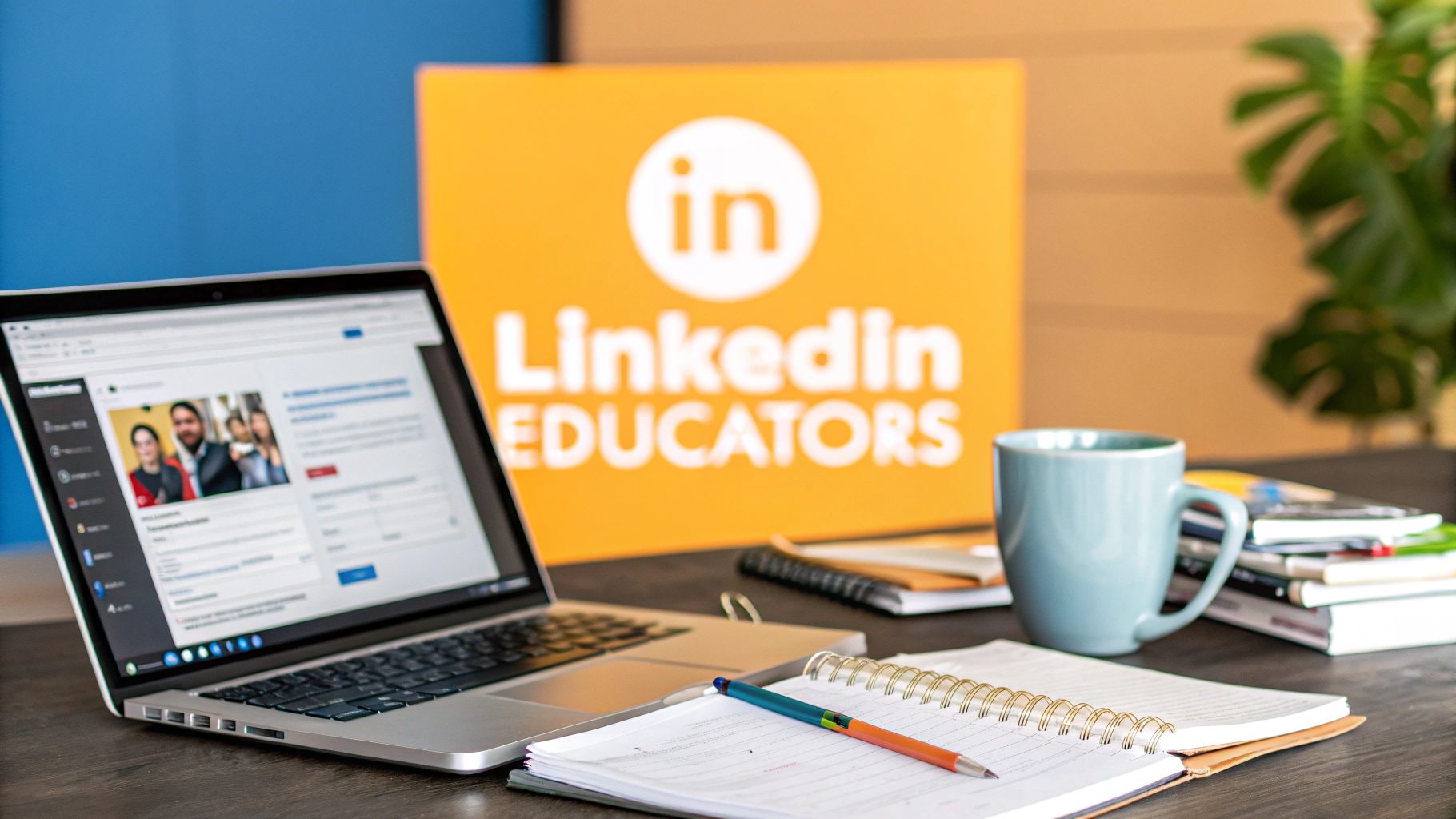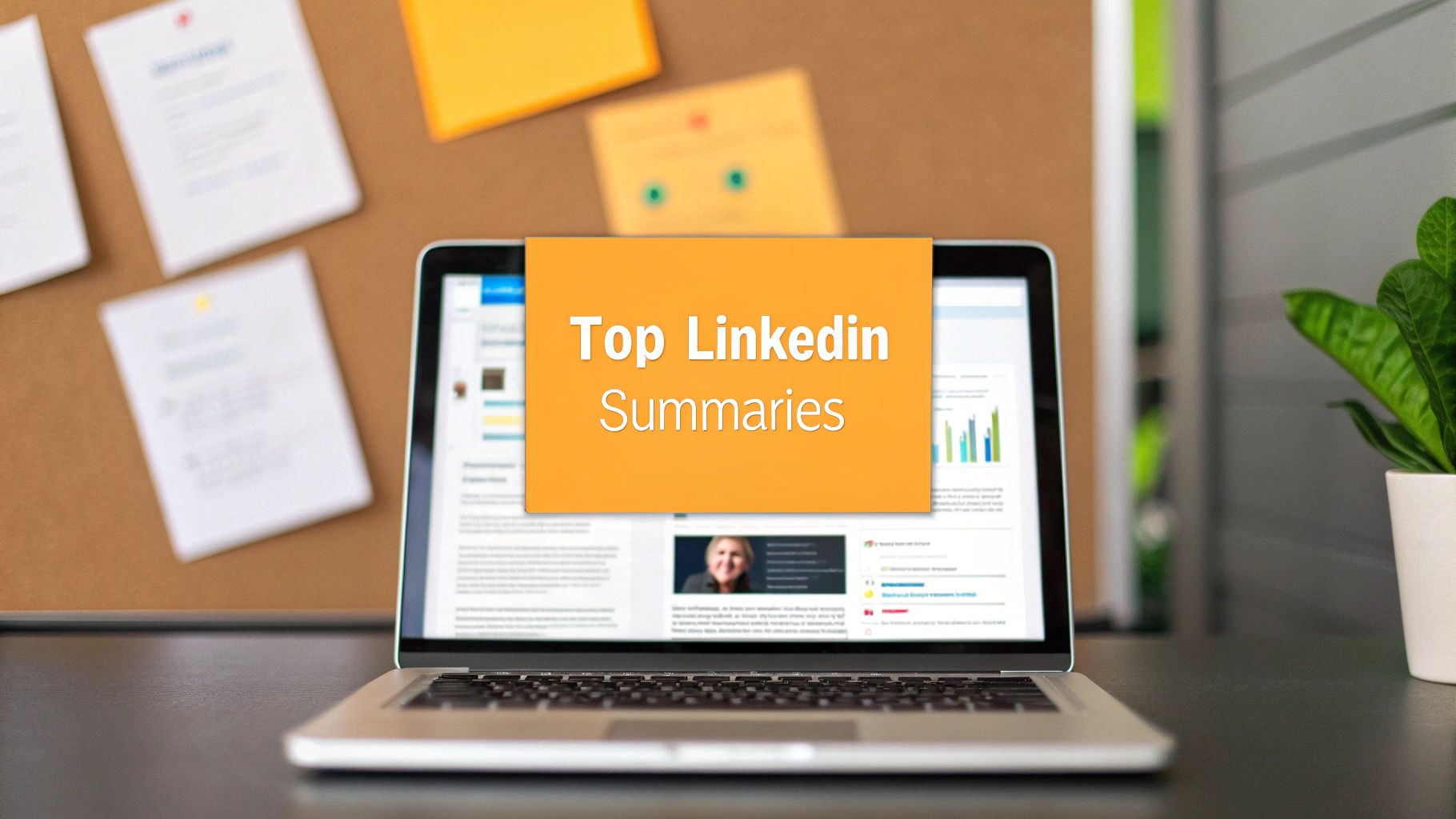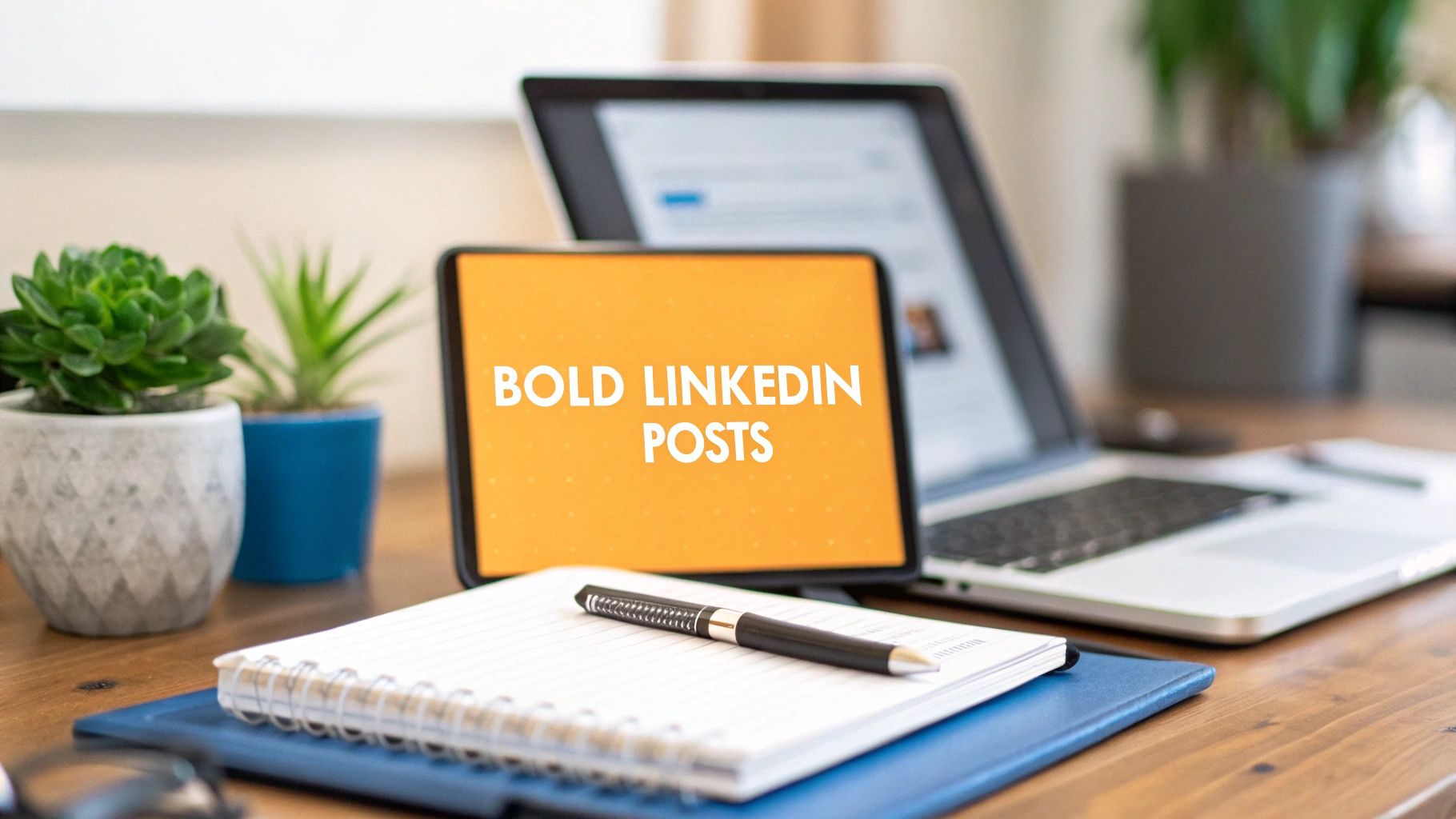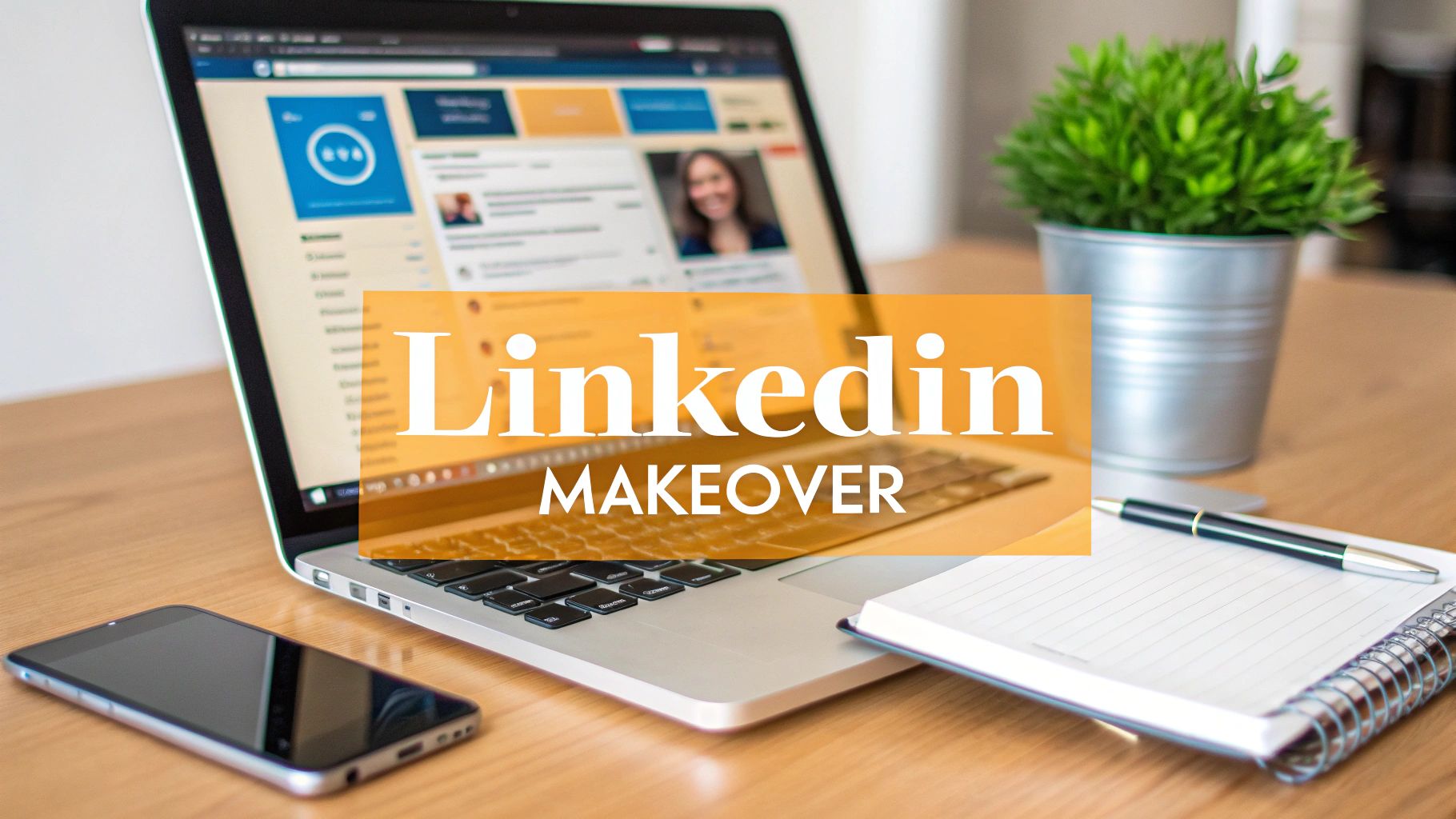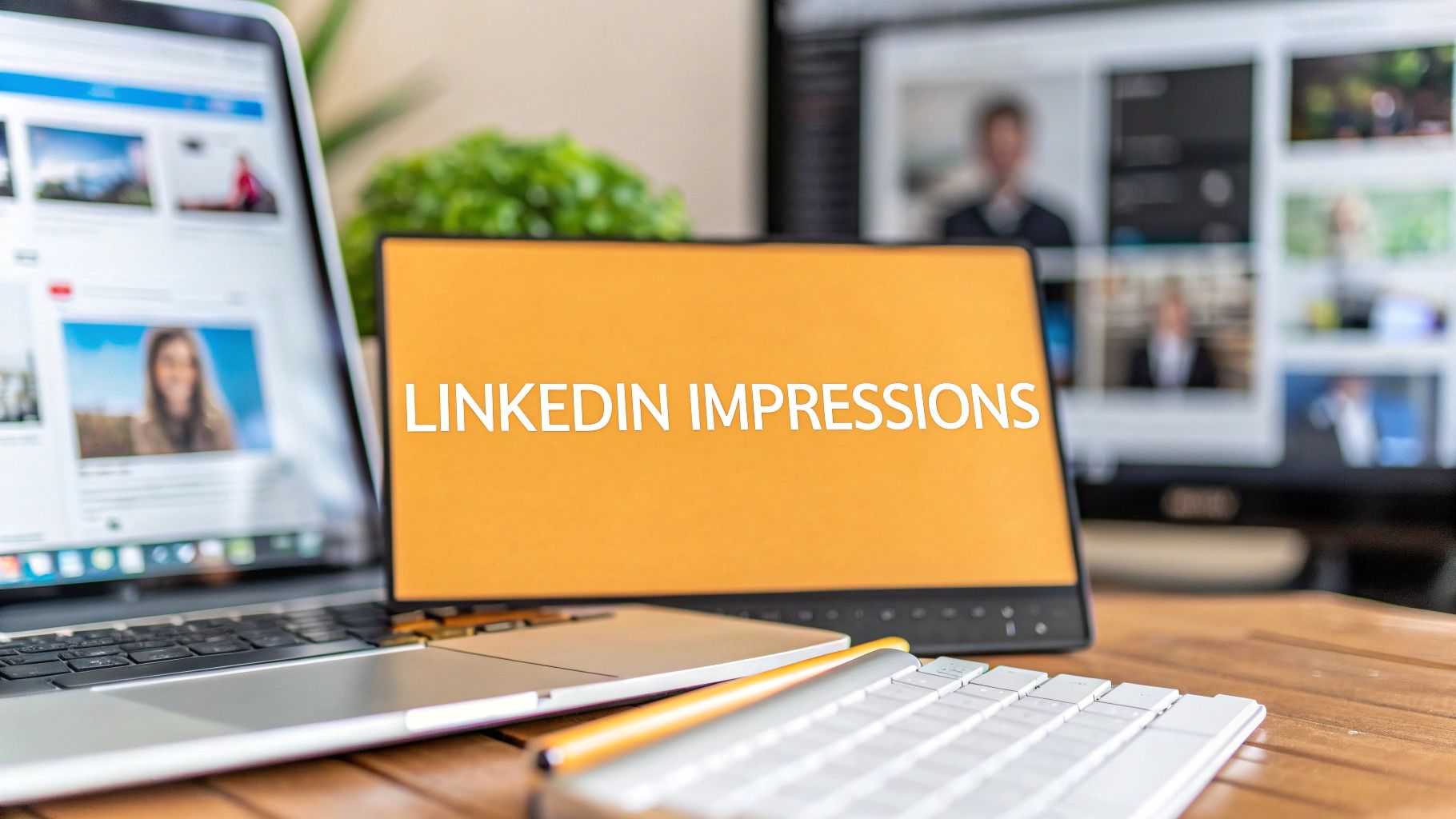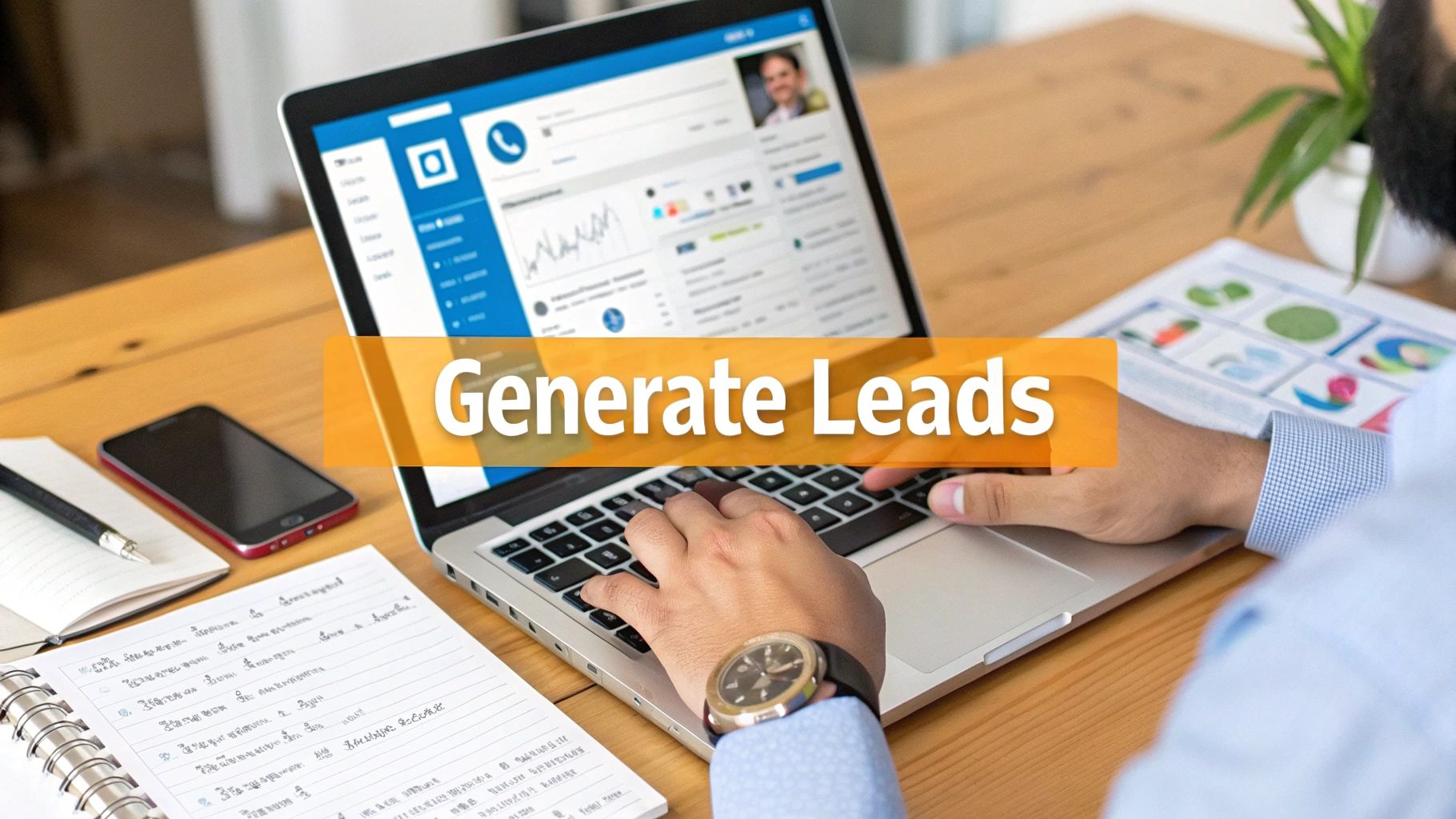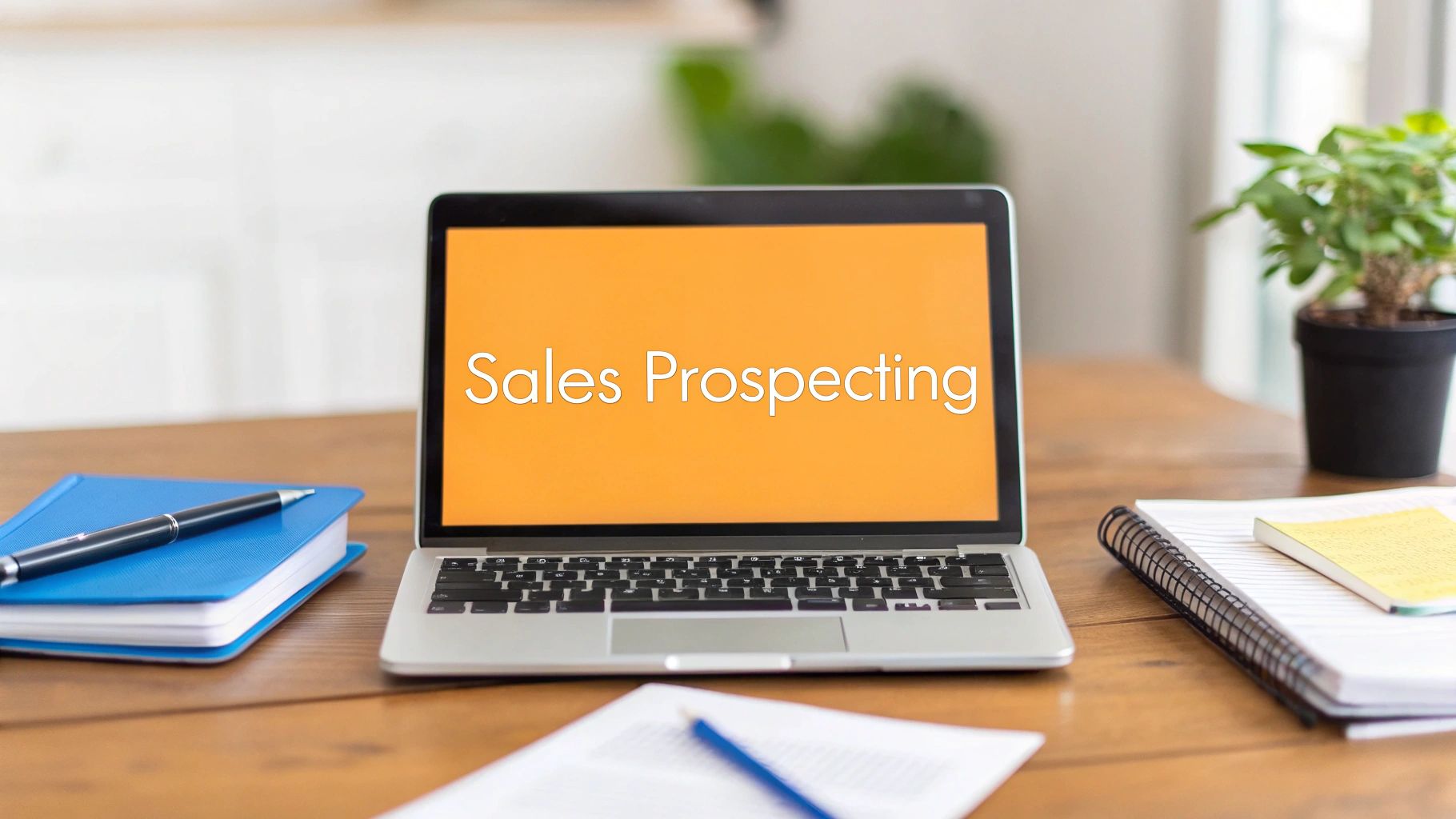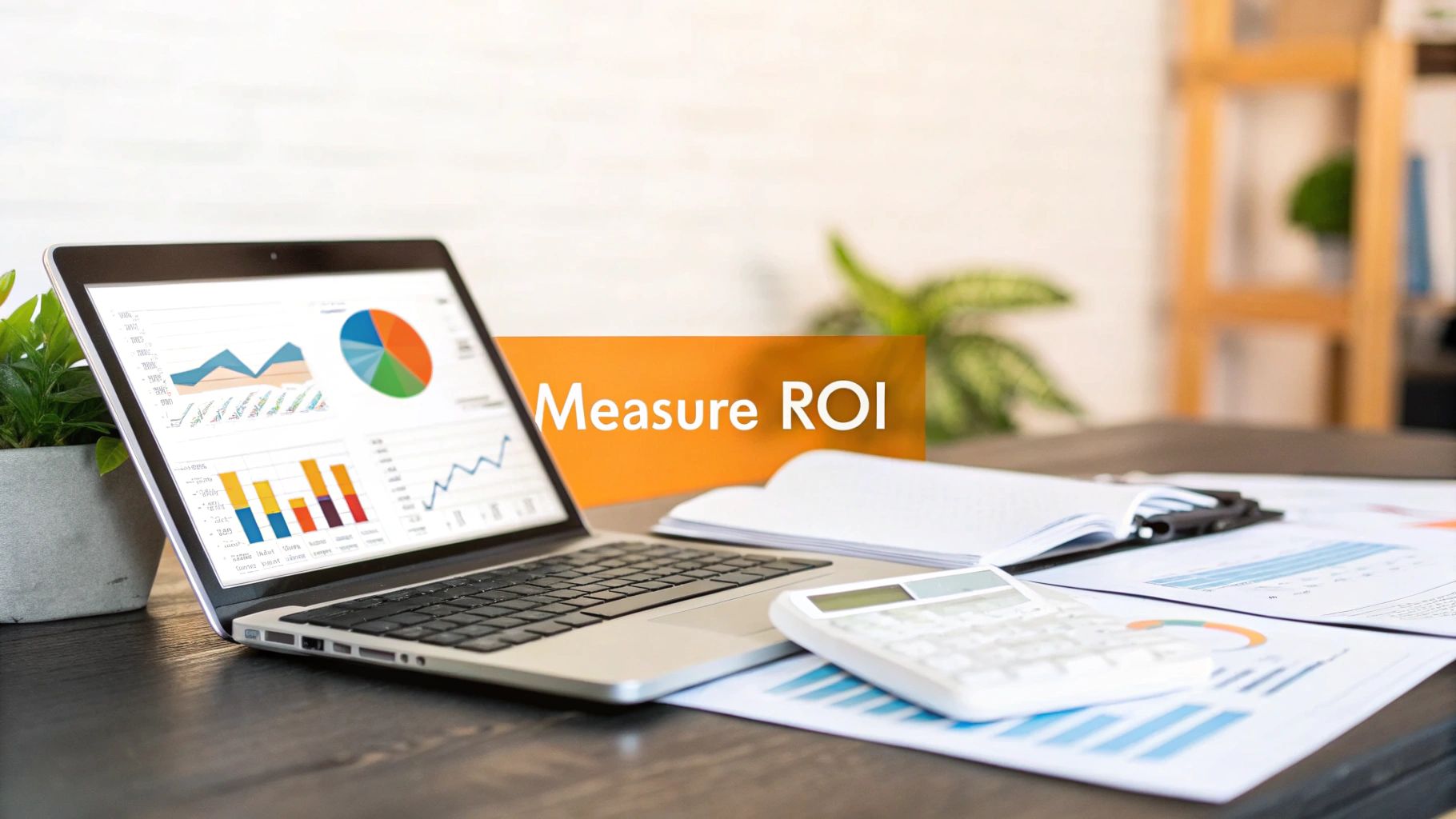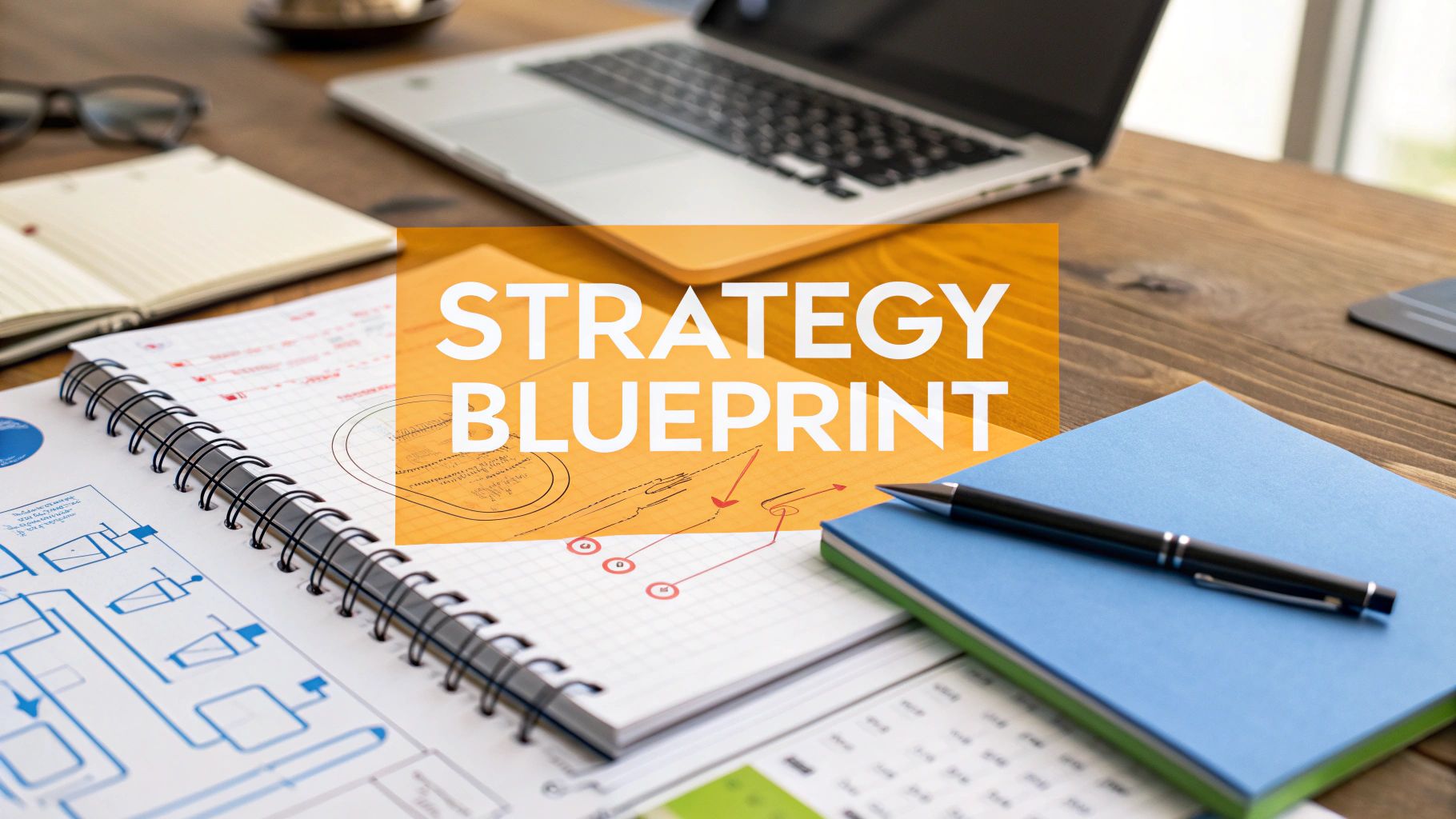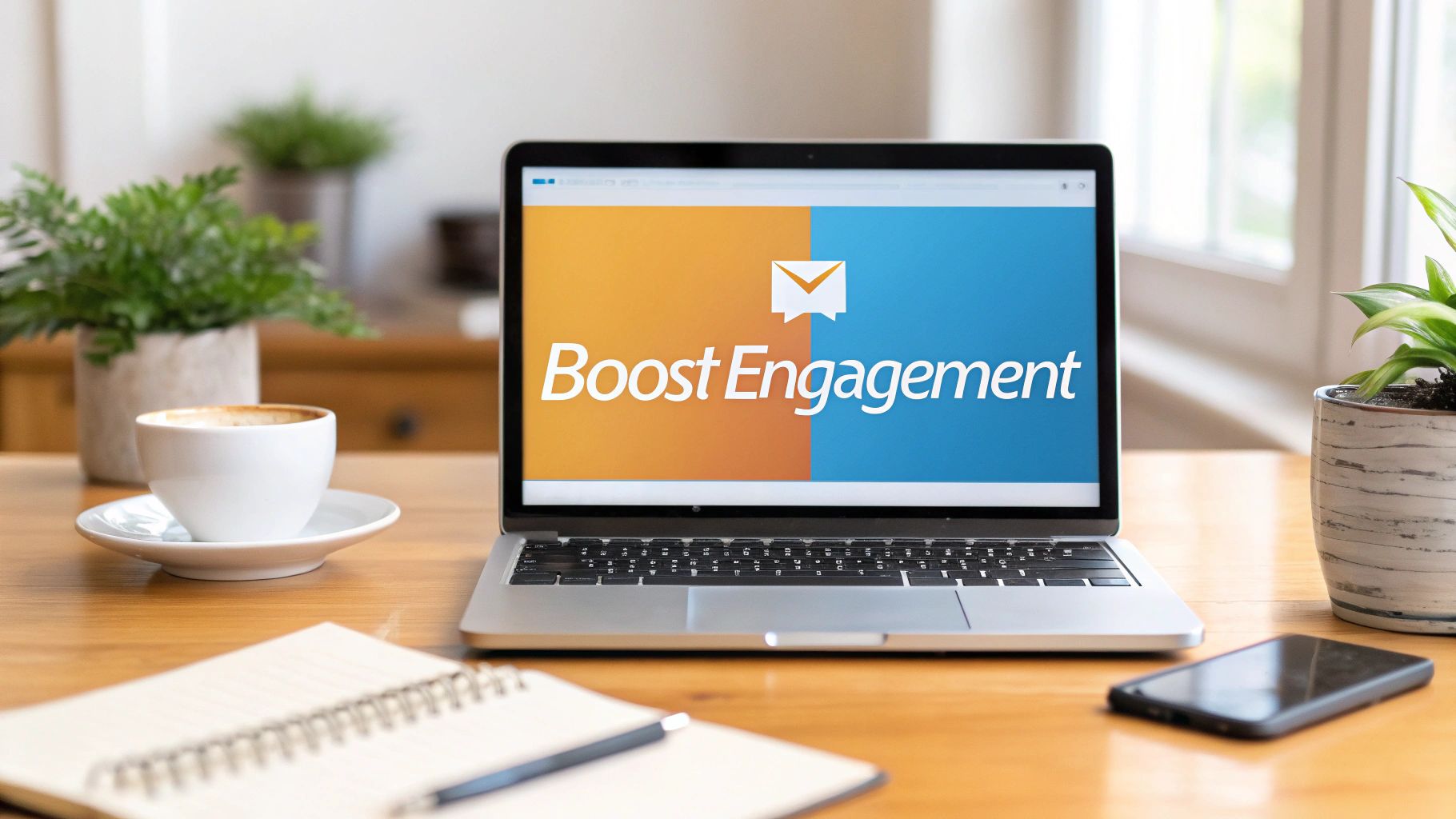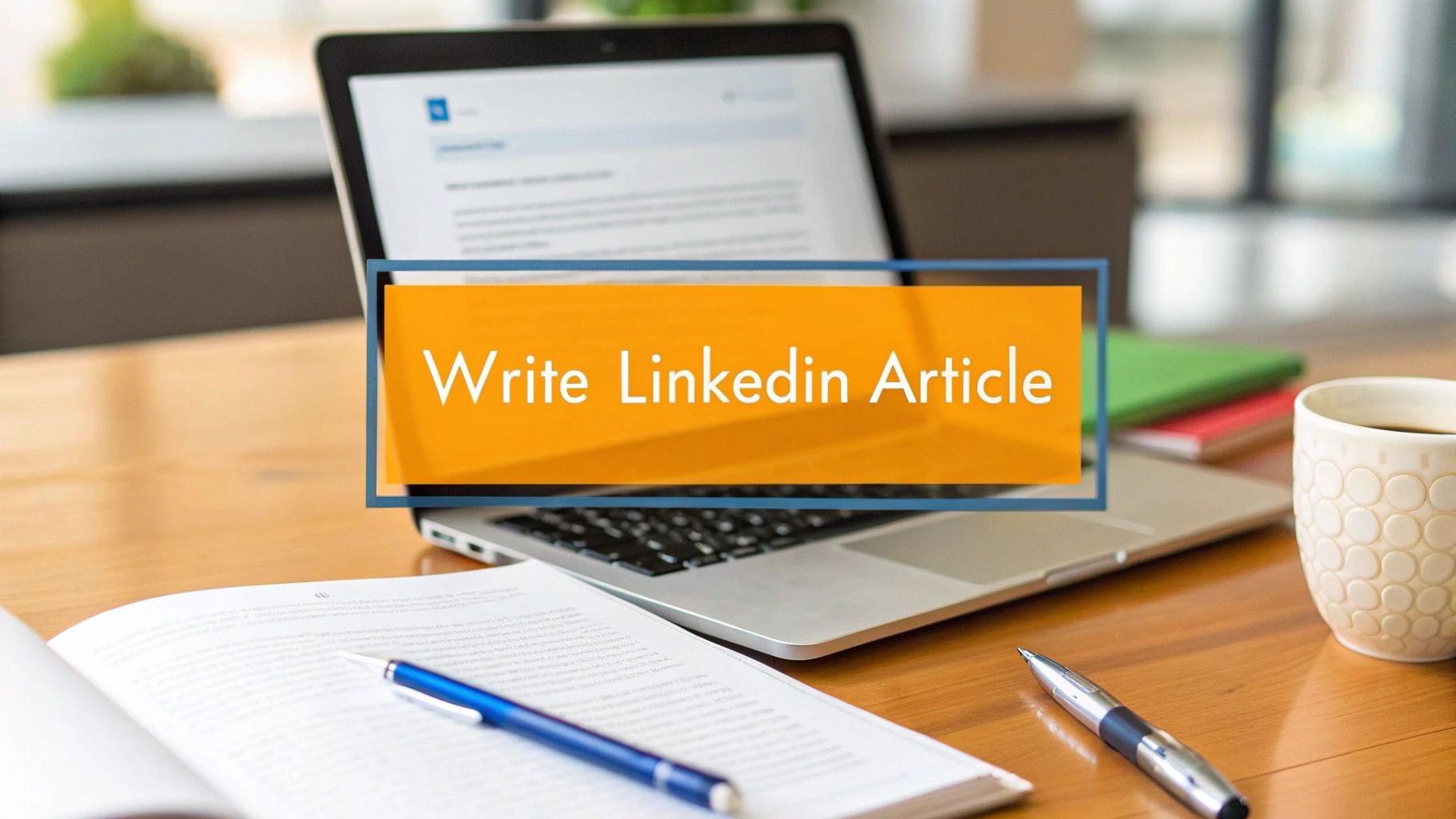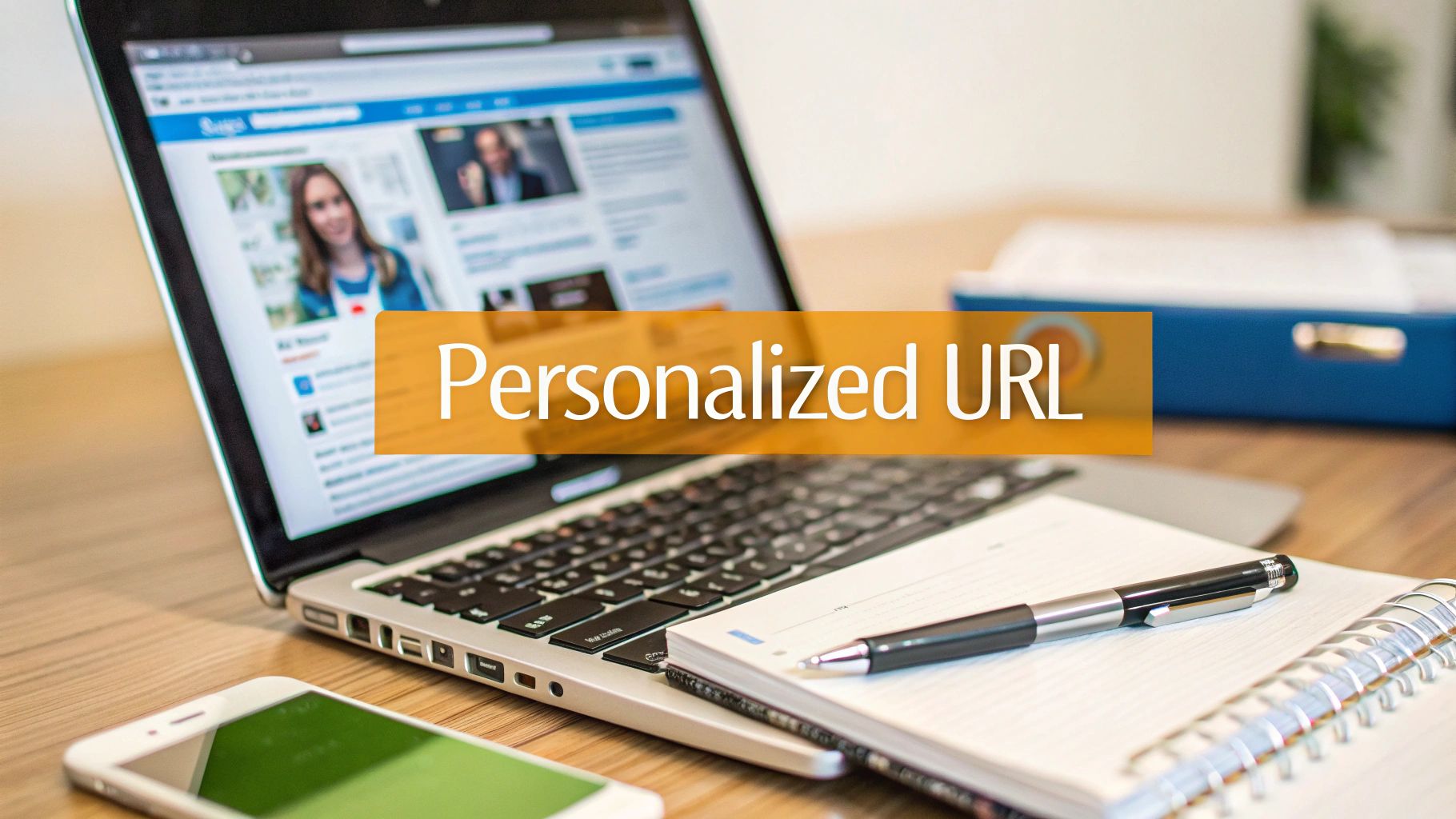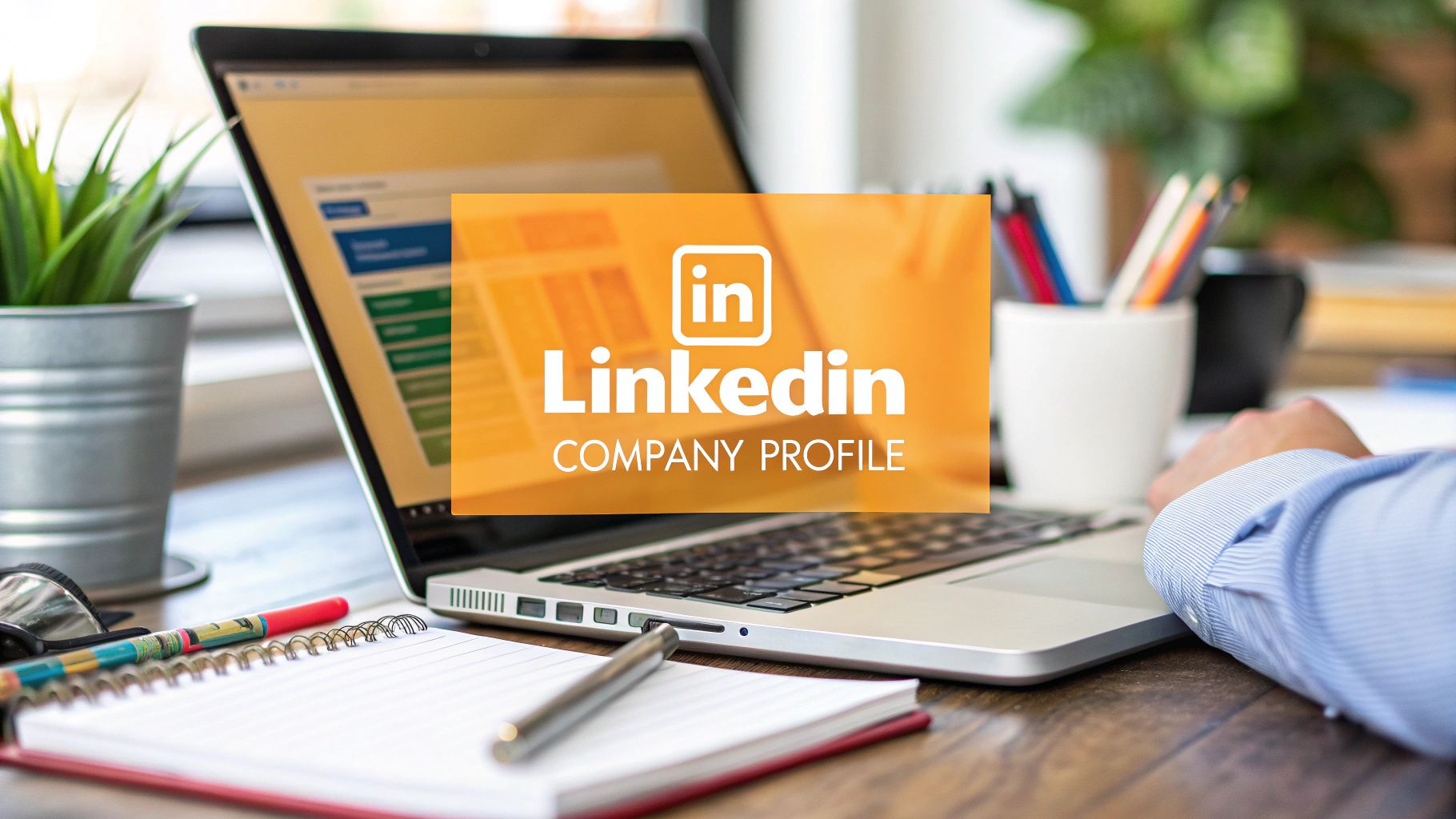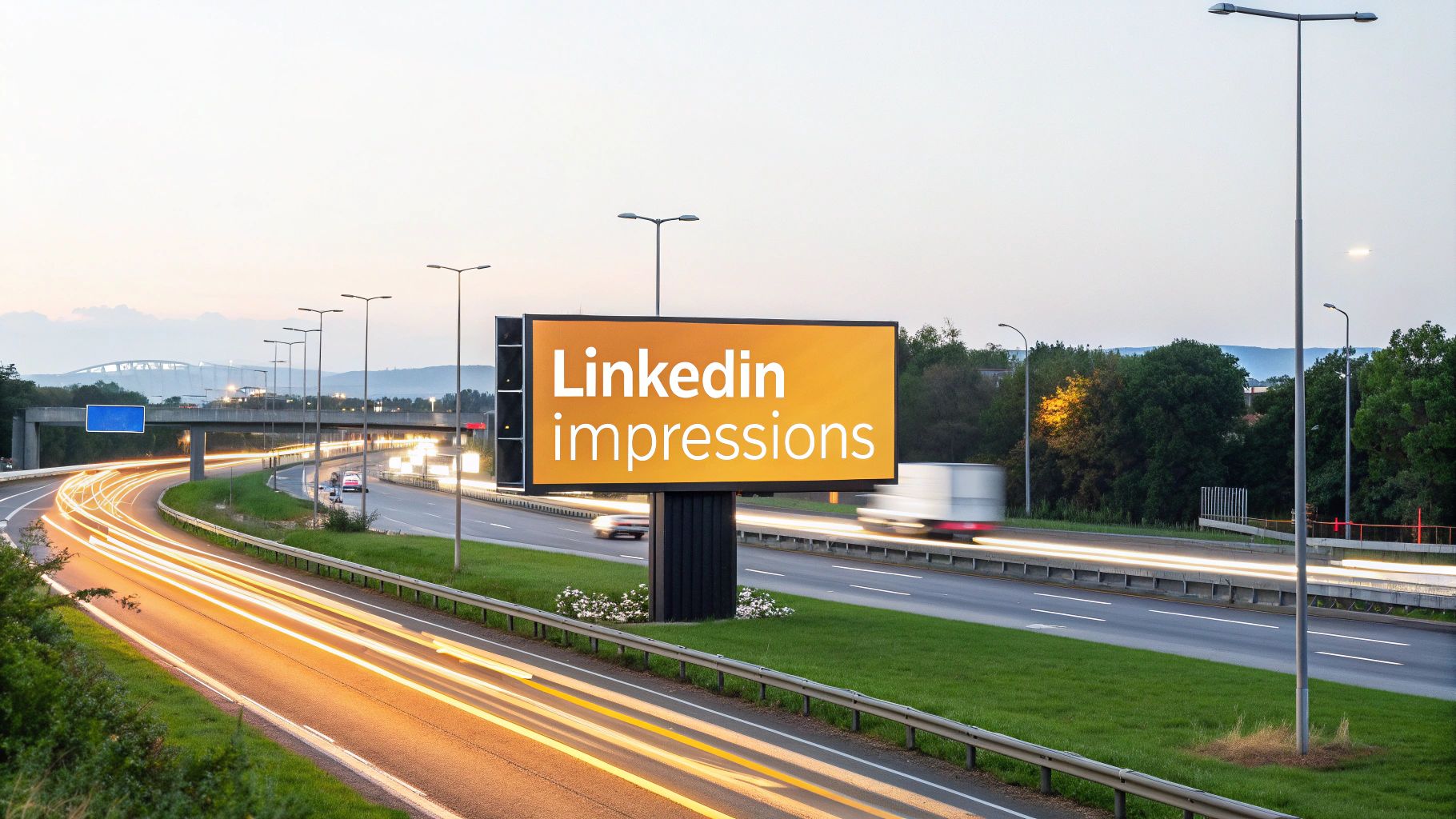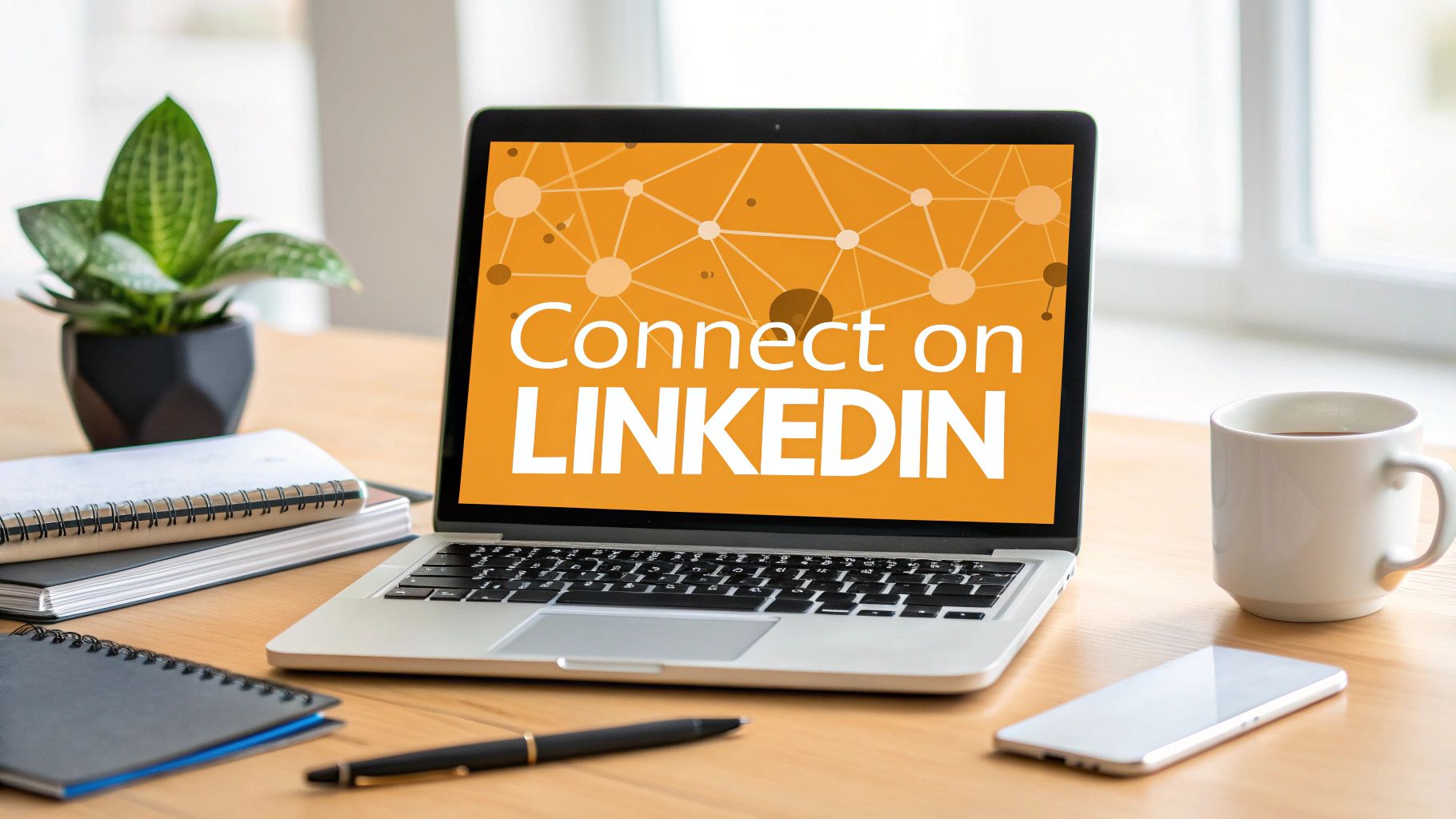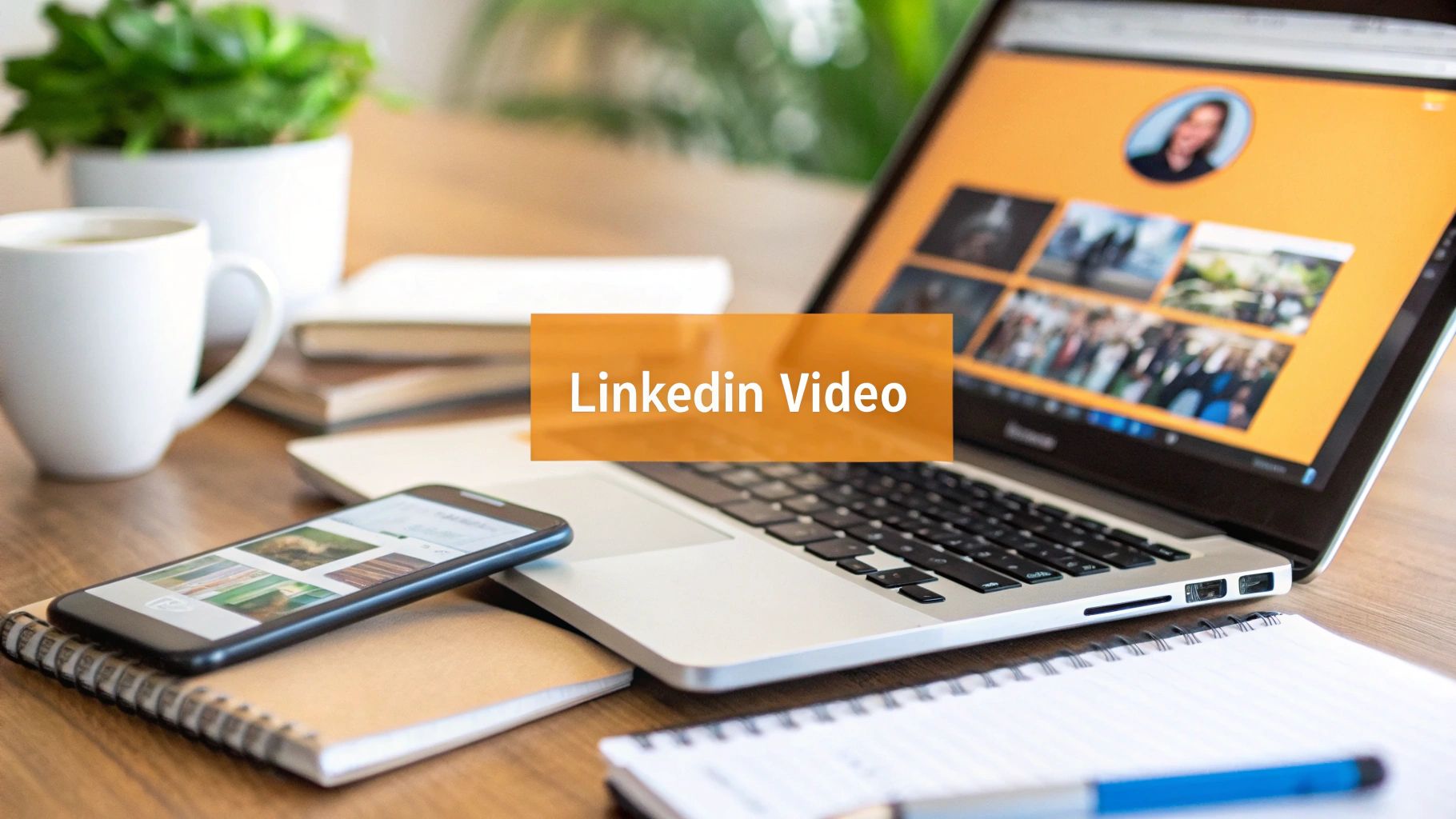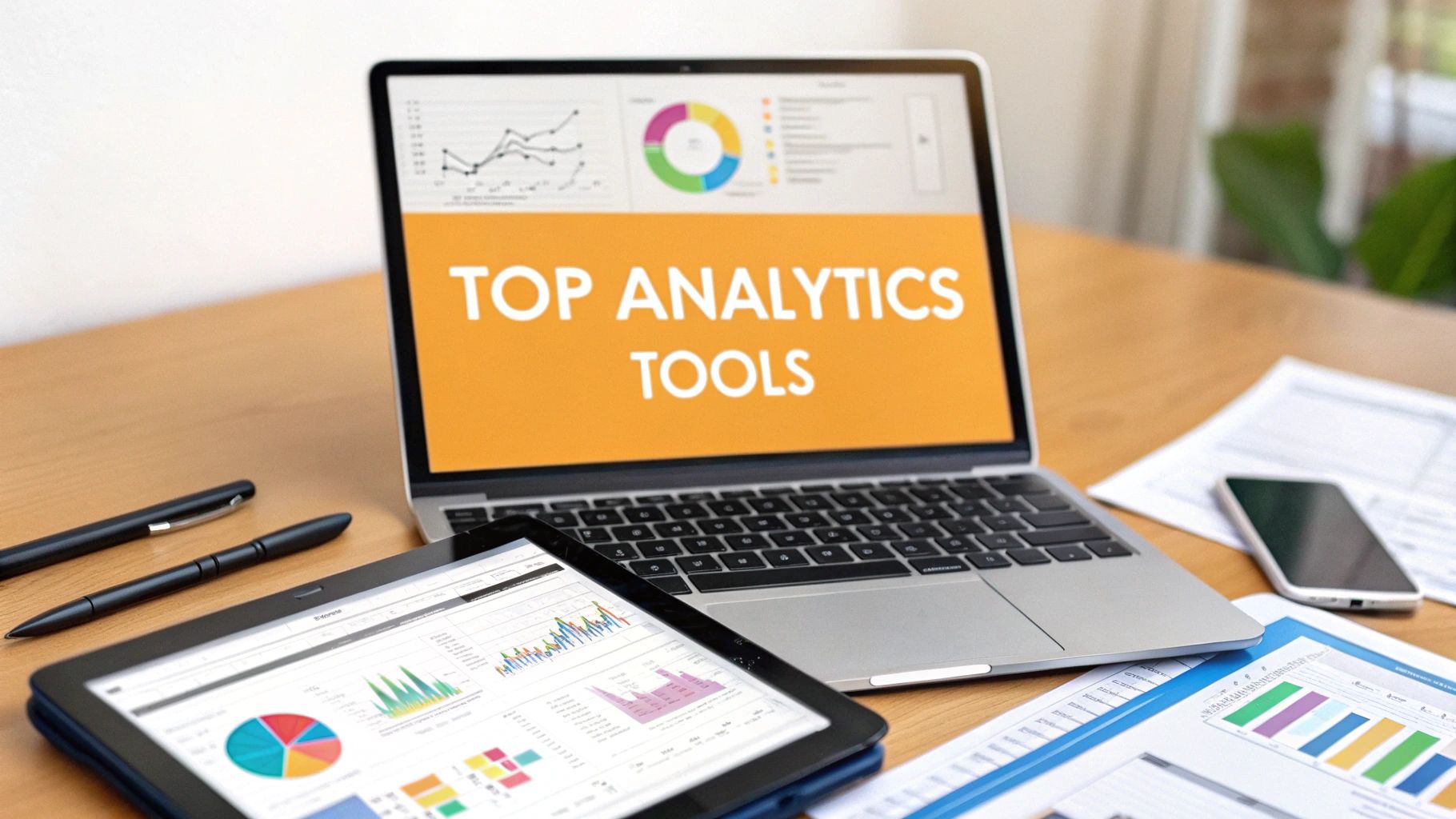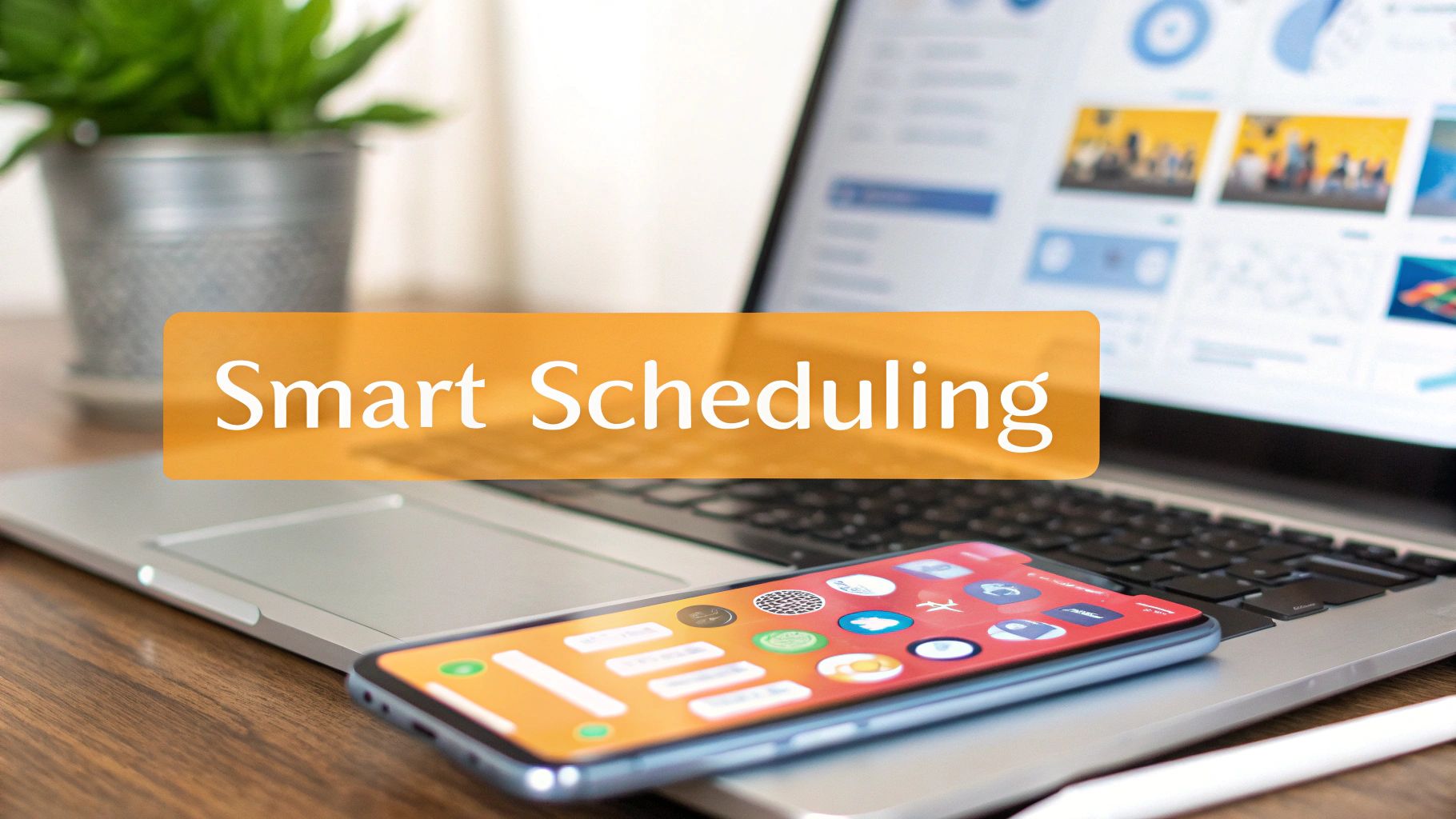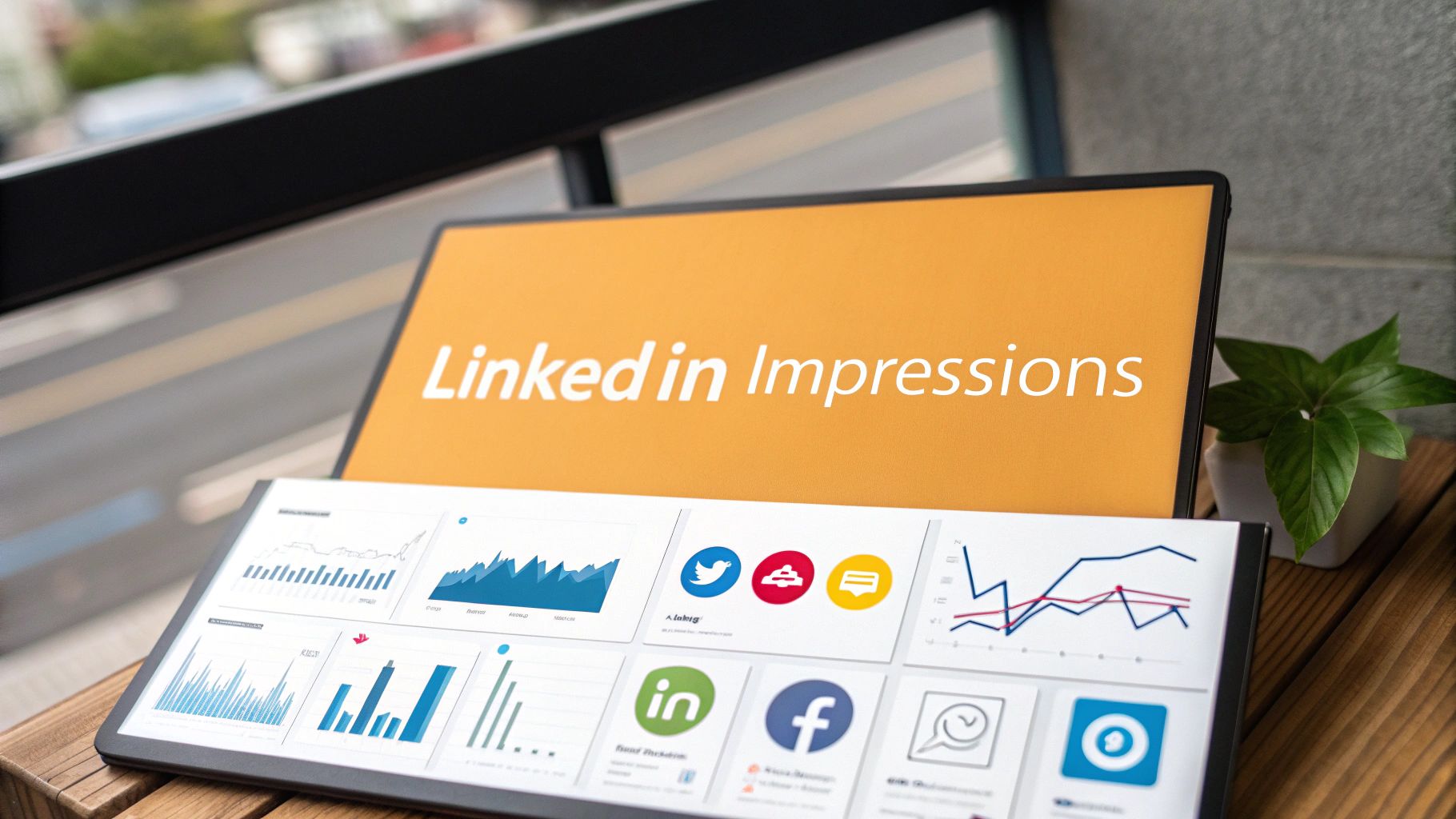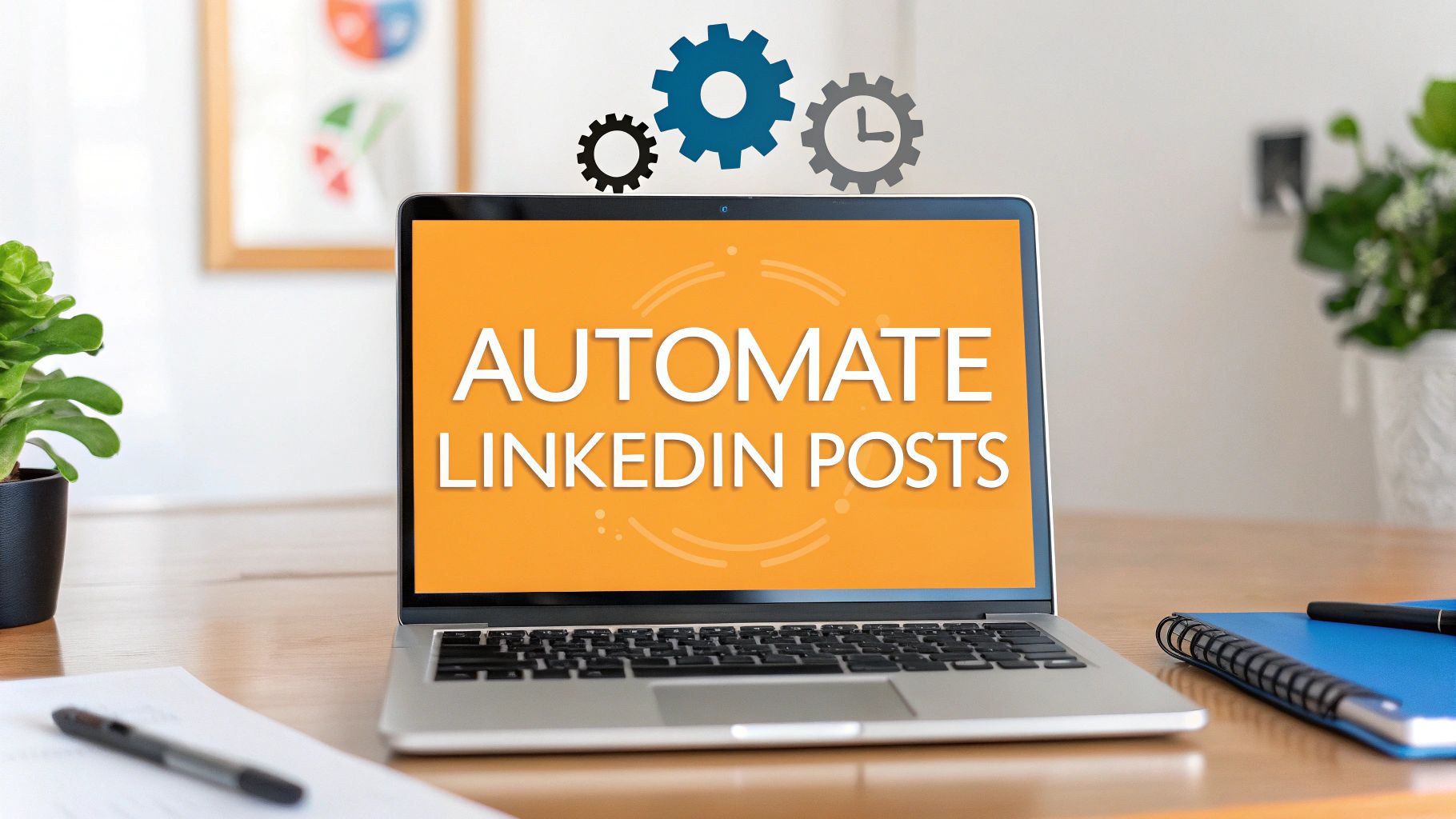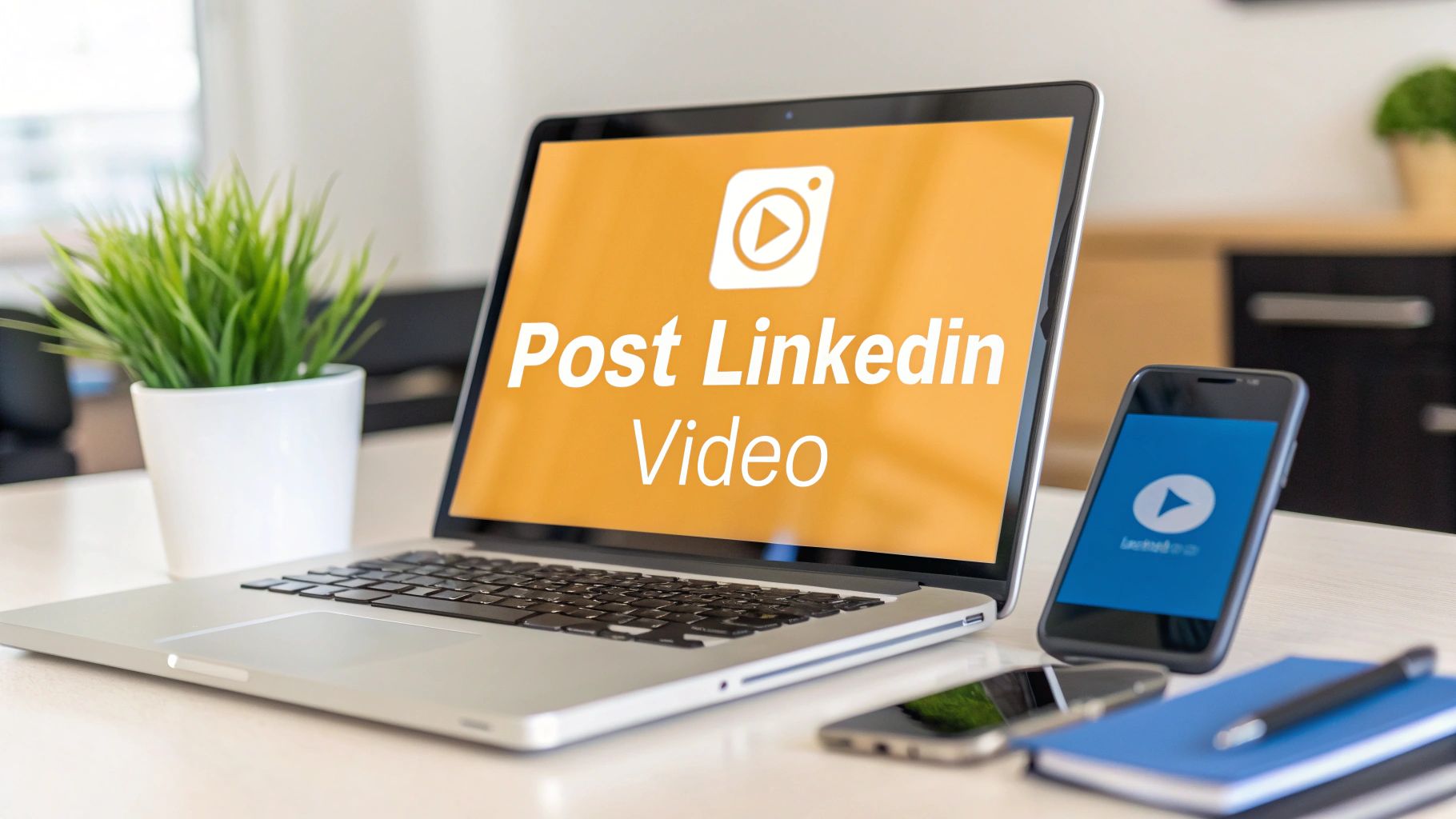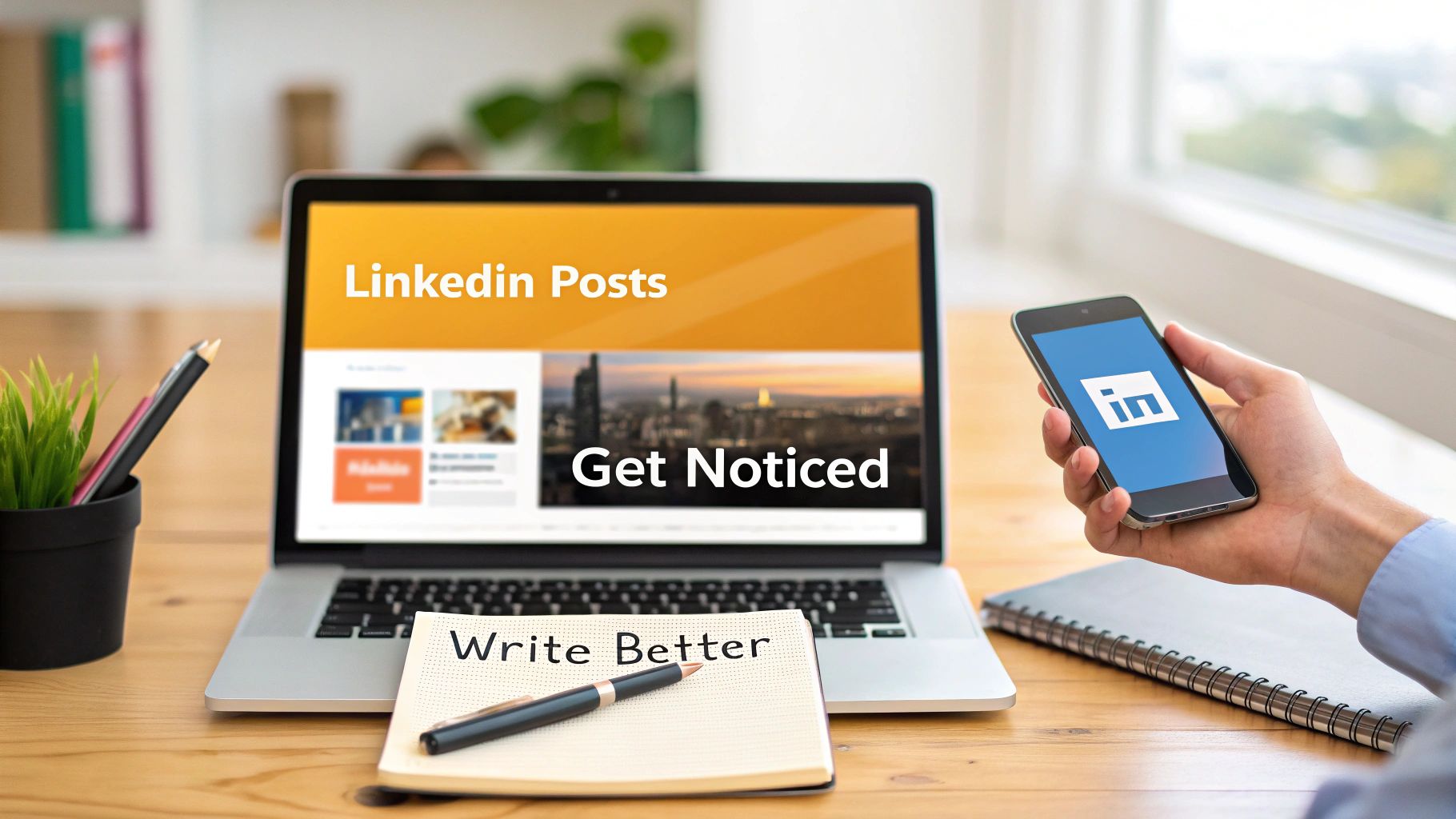Generating business leads is all about identifying and nurturing potential customers. But before you can do that, you need a rock-solid strategy. It all starts with two key things: defining your ideal customer and figuring out what a "qualified" lead actually looks like for your team.
Building Your Foundation for Quality Leads

Before you can really learn how to generate business leads, you need a game plan. Just diving into tactics without a clear strategy is like trying to build a house without a blueprint—it gets messy, expensive, and rarely works out.
The real secret to success isn't just chasing every possible prospect. It's about attracting the right people from the get-go. This foundational work is all about getting crystal clear on who you're talking to. It ensures every piece of content, every LinkedIn post, and every email is aimed at someone who will genuinely benefit from what you offer.
Define Your Ideal Customer Profile
Your Ideal Customer Profile (ICP) is way more than just a job title and a company size. A truly useful ICP gets into the nitty-gritty of your target buyer's mindset. What are their biggest professional headaches? What goals are they desperately trying to hit this quarter?
When you understand these pain points, you can shape your messaging to connect on a much deeper level.
Think about these things when you're building your ICP:
- Pain Points: What specific problems that you solve are keeping them up at night?
- Goals: What does a "win" look like for them professionally, and how can you be the one to help them get there?
- Watering Holes: Where do they hang out online? This could be specific LinkedIn groups, industry forums, or certain blogs they follow religiously.
A well-defined ICP is your marketing compass. It guides everything from the topics you write about to your ad targeting, making sure you don't waste time and money on an audience that will never buy from you.
Clarify What a Qualified Lead Means
Let's be real—not all leads are created equal. Someone who downloaded a free checklist is in a completely different headspace than someone who just requested a personalized demo. You have to decide what makes a lead "qualified" for your business.
This simple distinction is what separates the casual browsers from the serious buyers.
It's also a massive budget-saver. The average cost per lead across all industries is now around $198. That number alone shows how critical it is to focus on quality over quantity. For a closer look at effective tactics, you can explore these proven B2B lead generation strategies to start building a sales pipeline with the right kind of prospects.
This table helps you define and prioritize your lead generation efforts by outlining key strategies and their primary outcomes, helping you align your actions with your business goals.
Defining Your Lead Generation Goals
| Goal | Key Strategy | Primary Metric (KPI) |
|---|---|---|
| Increase Brand Awareness | Content Marketing, Social Media Engagement | Website Traffic, Social Impressions, Follower Growth |
| Generate High-Quality Leads | Gated Content, Webinars, Demo Requests | Marketing Qualified Leads (MQLs), Conversion Rate |
| Boost Sales Pipeline Velocity | Lead Nurturing Emails, Retargeting Ads | Sales Qualified Leads (SQLs), Sales Cycle Length |
| Improve Customer Retention | Customer-focused content, Upsell campaigns | Customer Lifetime Value (CLV), Churn Rate |
Having clear goals and the right metrics from the start ensures your efforts are not only measurable but also directly contribute to what matters most: growing the business.
Getting Serious About High-Quality B2B Leads on LinkedIn
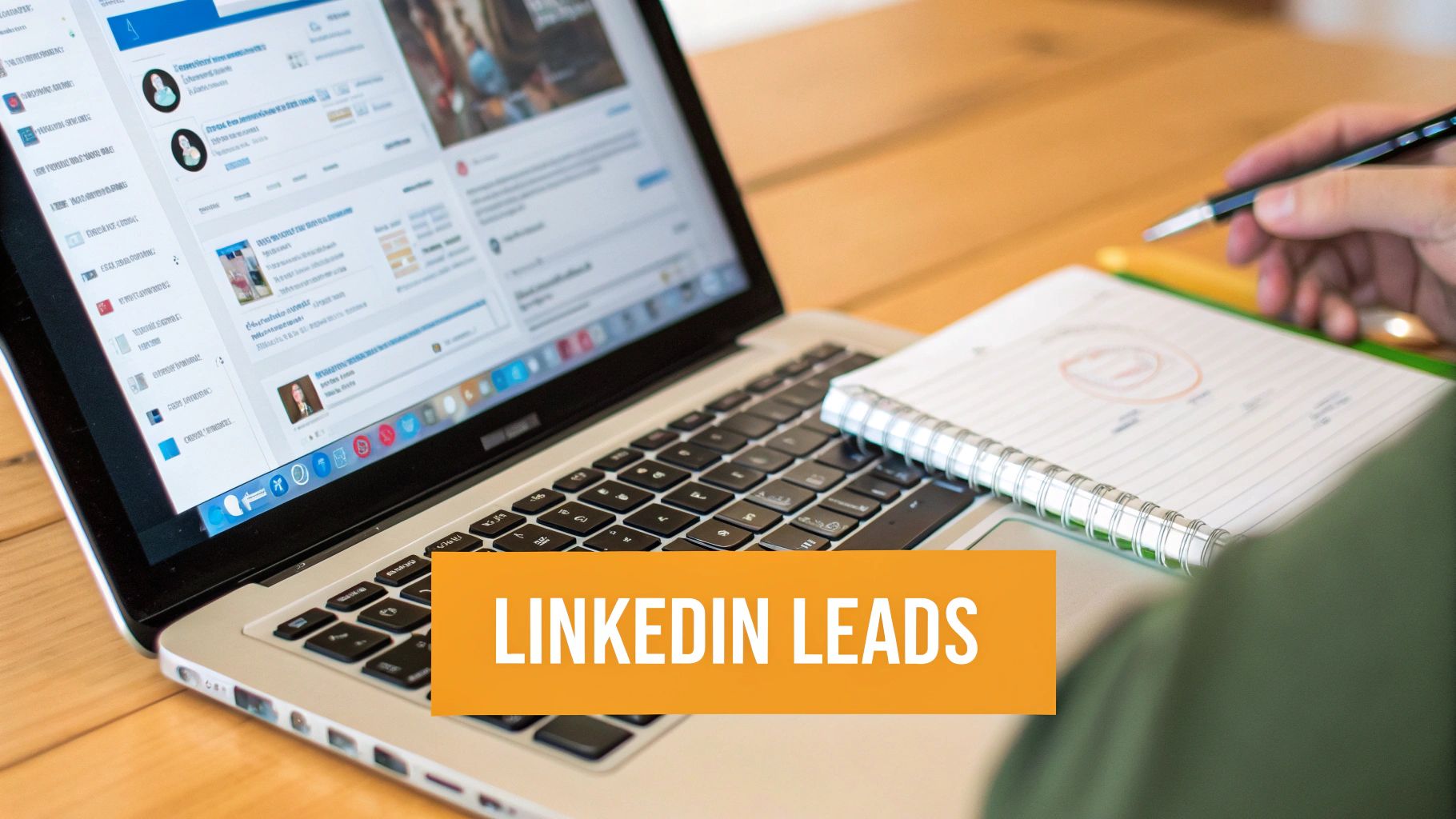
If you're in the B2B world, let's be honest: LinkedIn isn't just another social media app on your phone. It’s the main event. It's where your future clients are hanging out, talking shop, and, most importantly, making buying decisions. But just having a profile isn't a strategy—it's just a listing. You need an intelligent, proactive game plan to actually generate business leads.
The numbers don't lie. A staggering 89% of B2B marketers now turn to LinkedIn for lead generation. Why? Because it works. 62% of them say it’s their top source for high-quality leads. With over a billion users, the pond is massive, but you can't just cast a net and hope for the best. You need the right bait. You can get more details on how businesses are crushing it with these LinkedIn lead generation statistics.
Crafting Content That Actually Starts a Conversation
Stop posting boring company updates. Nobody cares about your latest press release. The kind of content that pulls in leads on LinkedIn is the stuff that genuinely helps, teaches, or inspires someone. Your mission is simple: stop the scroll and make your ideal customer think, "Wow, this person gets me."
The quickest way to figure this out is to see what's already crushing it. Go on a little recon mission. Scroll through the feeds of industry thought leaders and, yes, even your direct competitors.
- Find the Viral Hits: Hunt for posts with way more likes and comments than usual. Was it a personal story? A controversial take on a common problem? A super-practical tip?
- Dissect the Format: Pay attention to how they said it. Was it a slick carousel, a quick poll, a short video, or just plain text? The package is often as important as the present inside.
- Mine the Comments for Gold: The comment section is your secret weapon. What are people asking? What are they debating? This is pure, unfiltered feedback you can spin into your next knockout post.
Think of your LinkedIn profile as a dedicated landing page. It needs a crystal-clear headline saying who you help, an "About" section that speaks directly to their biggest headaches, and a featured section showcasing your best stuff.
Engaging With a Purpose (Not Just to Make Noise)
Everyone knows you should "engage" in groups and on other people's posts, but most people are doing it all wrong. Dropping a link to your blog is just spam. A lazy "Great post!" comment is totally invisible. Real engagement is about adding real value to the conversation.
Let's say a marketing director posts about being fed up with getting junk leads. Instead of jumping in with your sales pitch, try adding a thoughtful comment like, "Have you tried getting hyper-specific with your Ideal Customer Profile? We found that when we tightened ours up, we cut unqualified inquiries by almost 30%." See the difference? You're an expert, not just another salesperson.
To really build a system around this, check out our guide on LinkedIn lead generation strategies that actually convert connections into clients.
Perfecting Your Non-Spammy Outreach
Believe it or not, direct messages still work wonders—when you don't sound like a robot. The magic formula is personalization plus a clear reason for reaching out. A generic, copy-pasted pitch is dead on arrival. A message that shows you actually took two minutes to do some research? That gets a reply.
Your outreach message needs to hit three key points:
- Be Relevant: Mention something specific, like a post they just shared, a recent company win, or a connection you have in common.
- Be Quick: Nobody has time for an essay in their DMs. Get straight to the point.
- Be Helpful: Offer a tiny piece of value—an interesting article, a quick insight—before you even think about asking for something.
This simple shift turns a cold, awkward message into a warm introduction. It's one of the single most powerful ways to generate solid business leads right from the source.
Creating Content That Actually Pulls In Leads
LinkedIn posts are fantastic for sparking conversations, but a truly great lead generation machine works for you even when you’re not online. This is where content marketing steps in. I'm not just talking about blogging; I mean building an entire ecosystem of genuinely helpful resources that draws prospects in 24/7.
At its core, great content does one thing really, really well: it solves a specific problem for your ideal customer. Think of it as offering a helping hand long before you ever ask for a sale. There's a reason companies with a blog generate 67% more leads on average—that consistent value adds up.
Crafting Lead Magnets People Actually Want
A lead magnet is simply a valuable freebie you offer in exchange for an email address. The key word is valuable. People guard their inboxes, so your offer needs to be a total no-brainer. Forget the generic "subscribe to our newsletter" CTA and think more about a high-impact, quick-win solution.
Here are a few ideas for lead magnets that I've seen work time and time again:
- Actionable Checklists: A simple one-page PDF that guides someone through a task. For instance, a "10-Point LinkedIn Profile Optimization Checklist" is something someone can use immediately.
- Exclusive White Papers or Reports: This is your chance to go deep on an industry trend, ideally with your own data or unique perspective. It instantly positions you as an expert.
- Webinar Recordings: Did you host a popular webinar? Gate the recording. Anyone who missed it gets another chance to learn, and you get a fresh lead. It's a win-win.
- Resource Guides or Toolkits: This is one of my favorites. Curate a list of the best tools, articles, or resources for a specific challenge. You're saving them hours of research, and that's incredibly valuable.
The whole point is to create something so useful that your ideal customer feels like they're getting the better end of the bargain.
Let SEO Bring Leads to Your Doorstep
Let's be honest, the best leads are the ones who find you. That’s the magic of Search Engine Optimization (SEO). It's all about making your content pop up when people are actively searching for solutions on Google. When someone types in a problem and your article is the first thing they see, you've just snagged a lead with serious intent.
Every single blog post you publish is a new digital doorway to your business. It’s a chance to rank for another specific question your ideal customer is asking, pulling in traffic you would have otherwise completely missed.
For example, don't just go after a huge, broad term like "business leads." Get more strategic and target long-tail keywords. These are longer, more specific phrases like "how to generate leads for a consulting business." When you create content around these specific queries, you attract a much more qualified audience—people who are already deep into their research and closer to making a decision.
If you want to go deeper on building this out, check out this comprehensive content marketing strategy guide.
Think Beyond Just Blog Posts
While blog posts are the bedrock of a good content strategy, people consume information in all sorts of ways. To really grab attention and turn readers into leads, you need to mix up your formats.
Short-form video is huge right now, and it's perfect for platforms like LinkedIn, Instagram Reels, or YouTube Shorts. You can easily pull one key takeaway from a long blog post and turn it into a 60-second video tip. Infographics are another great tool. They make complex data easy to understand and super shareable, which can massively expand your reach and drive traffic back to your site.
By using a multi-format approach, you ensure your message gets in front of people wherever they hang out online, building a much more powerful engine for generating business leads.
Turning Your Website Into a Lead-Generation Machine
So, you've done the hard work. Your LinkedIn posts are getting noticed, your content is driving clicks, and people are finally visiting your website. But here's the million-dollar question: what happens next?
If your website isn't set up to capture those visitors, all that effort goes down the drain. Think of it like a salesperson who does a brilliant pitch but forgets to ask for the business. A few smart tweaks can turn your site from a passive brochure into your most effective salesperson, one that works 24/7.
The moment a visitor lands on your site, the clock starts ticking. You have minutes, maybe even seconds, to convince them to stick around. This is where your landing pages come in. They need to be sharp, clear, and laser-focused on one thing: getting that person to take action.
Crafting Landing Pages That Actually Convert
A good landing page has a single job: to convert a visitor into a lead. That’s it. Don't confuse people by cramming it with links to other parts of your site or distracting sidebars. The entire page should be built around your offer, whether you're asking them to sign up for a demo, download an ebook, or book a consultation.
Your call-to-action (CTA) button needs to pop. Use a color that stands out from the rest of the page and write text that creates urgency and clarity. Ditch the boring "Submit" button. Instead, try something specific that highlights the value, like "Get My Free Checklist" or "Schedule My Demo Now." You'd be surprised how much of a difference this tiny change can make.
This decision tree gives a great visual of how different content efforts funnel down into real, qualified prospects.
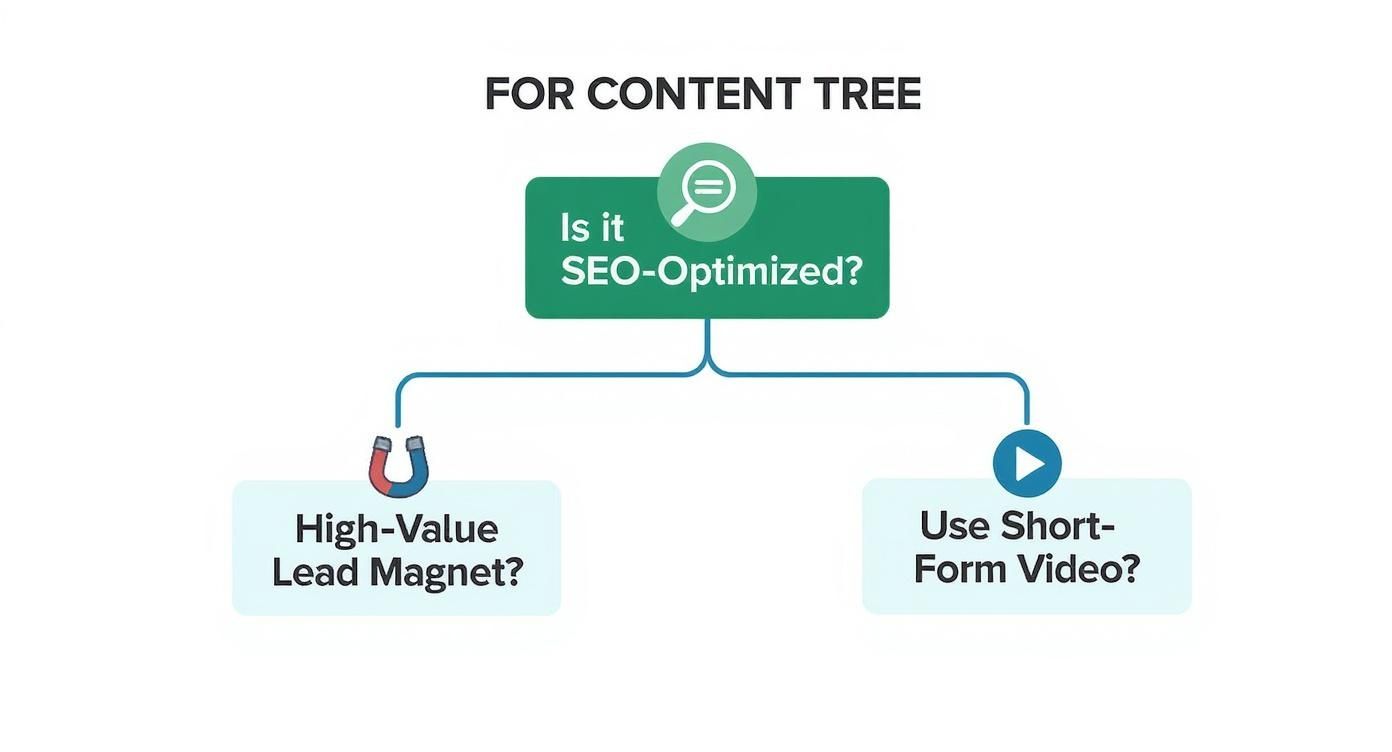
As you can see, SEO gets people in the door, but it's the high-value offer on your landing page that actually turns that traffic into a tangible lead.
Make It Easy (and Smart) for People to Reach You
Your contact forms are the final gatekeepers between a curious visitor and a new lead. Don't make them a chore to fill out. The more fields you require, the higher the chance someone will just give up and leave. Seriously, just ask for the basics to start—name and email are usually enough. You can always gather more details later on in the sales process.
Where you put your forms matters, too. Stick them "above the fold" (visible without scrolling) on your most important pages. It’s a simple move that can boost submissions big time. Also, consider using an exit-intent pop-up. It's a last-ditch effort to catch someone's attention before they click away, and it often works.
Your website isn’t just a digital brochure; it’s an interactive tool for engagement. A well-placed live chat widget can increase leads by 45% by offering real-time assistance and answering questions before a visitor bounces.
Finally, live chat and chatbots are no longer just a "nice-to-have" feature. They're powerful lead-gen tools. They can engage visitors, answer basic questions instantly, and even pre-qualify leads for you. By handling that initial conversation, you make sure no opportunity is missed, even outside of office hours. That immediate, helpful interaction is a fantastic way to build trust right from the get-go.
Building a Proactive Outreach Strategy
Look, sometimes the best leads won't just fall into your lap. You've got to go out and find them. That’s where proactive outreach comes into play.
But let's get one thing straight: this isn't about spamming a generic message to a thousand people and praying something sticks. That's a surefire way to get ignored and burn your reputation.
Real, effective outreach is about making genuine, one-to-one connections, even when you're doing it at scale. The idea is to build a relationship first. That way, when you eventually talk business, you're a familiar face, not just another random person cluttering their inbox.
The Art of the Personalized Cold Email
Cold emailing has a bad reputation, and honestly, most of it is deserved. But when it's done right, it's incredibly powerful. The secret? Personalization. A message that feels like it was written just for that one person will beat a generic template every single time. Your goal is to make your "cold" email feel warm.
Before you even think about hitting send, spend just two minutes on their LinkedIn profile. Seriously, that's all it takes. Find a recent post they shared, a company award, or a mutual connection you both trust. Dropping that into your opening line immediately shows you’ve put in a little effort.
A great cold email isn't a sales pitch. It’s the start of a conversation. Your only goal for that first message is to get a reply, not to close a deal. Keep it short, make it relevant, and focus on them, not you.
Turning Networking Into Real Opportunities
Whether you're at a virtual conference or shaking hands at an industry event, networking is your golden ticket to building real relationships. You have to ditch the hard sell. Nobody likes being pitched to over lukewarm coffee.
Instead, just be genuinely curious about what other people are working on and the challenges they're up against.
Here are a few things I've learned that actually work:
- Listen more than you talk. Ask open-ended questions about their business and what they're trying to achieve this year. People love talking about their work. Let them.
- Find a way to help first. Can you introduce them to someone who could solve a problem for them? Or maybe share a resource you found useful? Offering value with zero strings attached is the fastest way to build trust.
- Follow up with context. After the event, send a LinkedIn request or an email that reminds them of your chat. Something as simple as, "Great chatting with you about [specific topic we discussed]" makes all the difference.
Tracking Conversations So Nothing Slips Through
A great conversation is completely wasted if you drop the ball on the follow-up. This is where a simple CRM (Customer Relationship Management) tool becomes your secret weapon. And it doesn't have to be some complex, expensive software—when you're starting out, even a well-organized spreadsheet can do the trick.
The key is to track every single interaction. Jot down important details from your conversation, set a reminder for your next follow-up, and keep the momentum going. This simple system ensures a warm lead never goes cold just because you got busy.
By pairing smart tools with genuine human connection, you'll get the hang of one of the most reliable ways to generate business leads. For a deeper dive, check out these proven sales prospecting best practices.
Alright, let's talk about the part everyone skips but no one should: figuring out if any of this is actually working.
Launching a bunch of lead gen campaigns without tracking them is just throwing money into the wind and hoping for the best. You need to know your numbers. This is where you stop guessing and start building a predictable system for growth.
The trick is to avoid drowning in a sea of data. You only need to focus on a few key metrics that tell you the real story.
Are You Even Tracking the Right Things?
Seriously, not all data matters. To know if your lead generation efforts are paying off, you have to keep a close eye on the numbers that directly link back to revenue. This isn't about vanity metrics; it's about seeing what works and what's a waste of time.
Here are the big ones I always watch:
- Conversion Rate: This is your gut check. It’s the percentage of people who actually do the thing you want them to do (like fill out a form). If this number is low, your offer or your landing page probably isn't hitting the mark.
- Cost Per Lead (CPL): This one's simple but crucial. Just divide your total spend on a campaign by the number of leads it brought in. It tells you exactly how much you're paying to get someone interested.
- Lead-to-Customer Ratio: This metric is the truth-teller. It shows you the quality of the leads you're generating. Getting 1,000s of cheap leads is useless if none of them ever buy anything. You might be attracting the wrong crowd entirely.
Tracking these isn't just for fancy reports. It’s about getting real, actionable insights. If your LinkedIn ads have a sky-high CPL but your blog posts are bringing in leads for pennies on the dollar, you know exactly where to shift your budget next month.
Fire up your CRM and Google Analytics. These tools are your best friends for this. They'll show you precisely which channels are delivering the goods—whether it's LinkedIn, organic search, or paid ads—so you can make decisions based on cold, hard data instead of just a gut feeling.
A Few Common Questions We Hear All the Time
Getting into the weeds of lead generation always sparks a few questions. Let's tackle some of the big ones that pop up when we're talking with pros who are serious about filling their sales pipeline.
So, How Many Leads Do I Actually Need?
Everyone wants a magic number, but honestly, there isn't one. It all boils down to your own sales goals and, more importantly, your average conversion rate.
The best way to figure this out is to work backward. Start with your revenue target. How many new customers do you need to land to hit that number? From there, your lead-to-customer conversion rate will tell you exactly how many leads you need to be chasing.
Look, quality will always trounce quantity. I'd rather have a handful of perfectly qualified prospects who match my Ideal Customer Profile than a list of a hundred generic contacts any day of the week.
What's the Best Place to Find B2B Leads?
For the B2B world, LinkedIn is still the king of the hill. It's no surprise that a whopping 89% of B2B marketers live on the platform for lead gen—it's where the decision-makers are.
But, and this is a big but, the "best" channel is wherever your specific audience hangs out. Don't sleep on a solid SEO strategy or a well-crafted email outreach campaign. They can be goldmines, too.
How Long Until I Start Seeing Results?
This one really depends on the path you take. If you're running paid ads on LinkedIn or Google, you can see leads trickle in almost right away. It's fast, but it costs.
On the other hand, things like content marketing and SEO are more of a long game. You're building momentum over months, not days. The payoff? These strategies often deliver a more sustainable, and cheaper, stream of leads in the long run.
Ready to turn your LinkedIn profile into a machine that consistently brings in new leads? RedactAI is built to help you craft posts that get attention, spark conversations, and pull in the right kind of clients. Start creating for free at RedactAI.

